where truth resides
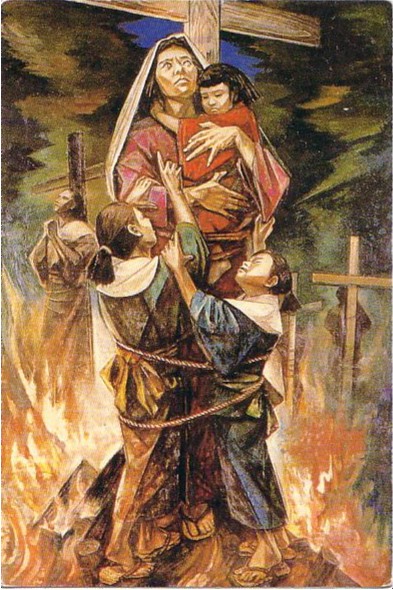
A Philosophy (Inspired by the Intercession of Tecla Hashimoto)
I am here posting a work in progress for the reader to get the general tenor of the thing, in the hopes of one day
finding a publisher for same. I am not a computer expert and the program I am using is somewhat primitive, so the
settings, images, typefaces, etc., may not be ideal and may even be a little bit off, but it is the text that is the thing.
All photos, images, and illustrations (called "Figures") will be in the right-
hand margin and my gloss on each paragraph will be in the left-hand margin. All Figures are posted according to
the Fair Use Laws of both Japan and the United States--i.e., 1) to educate and inform the general public and 2)
to report on current and historical events; 3) to thereby provide a benefit to society (which currently groans in
tribulation both locally and internationally) 4) in a way that is "transformative" (one might say "highly
transformative") 5) with no profit to myself. Credit for all are Figures found in the "Photo Credits" at the bottom of
each chapter and/or in the caption below the image, unless it is a stock" image of a flag, dollar
bill, etc. If I have accidentally posted anything that shouldn't be posted or failed to credit where I should
have, please contact me at the email address on our "Contact Us" page and I will take the image in question
down immediately. All biblical references are from the Douay-Rheims (the English translation from the
Vulgate) version of the Holy Bible, which can be found online. May God bless all those who read this philosophy
with a true spirit of wisdom and understanding, and may Tecla's many graces be showered upon them.
Chapter 1
When a huge earthquake hit Kobe, Japan, on the morning of January 17, 1995, at 4:36 a.m, it was not long before citizens, journalists, and civic leaders on both sides of the Pacific immediately noted the coincidence between this quake and the one that had hit in Los Angeles, California, exactly one year before, beginning with the date of the quake itself, for the Los Angeles Quake had hit on January 17, 1994, at 5:32 a.m. Most prominent among these civic leaders was President Bill Clinton who had just flown in from Denver, Colorado, to give a speech at California State University, Northridge (CSUN), on the one-year anniversary of the Los Angeles Quake, when he received news of the Kobe Quake, and included a commemoration to the victims of that quake in his speech, as follows: “‘Nature has struck again here at home in California with the floods and with extraordinary fury in the earthquake in Japan. I know all of you join with me in extending our profound condolences to the families of those in the Osaka-Kobe area of Japan who have suffered such a tremendous loss in the last day.’ Clinton asked the audience to join him in a ‘moment of silence’ for the earthquake victims.”[1]
Among the other coincidences which would be noted by the authorities, journalists, and lay people alike over time were: 1) both quakes hit directly under major urban centers with similar populations in the two million range (Kobe and the San Fernando Valley)[2]; 2) both shallow quakes originating about 11 to 12 miles under the earth’s surface[3]; 3) both quakes had similar moment magnitudes (Northridge 6.7, Kobe 6.8); and 4) both quakes lasted about 20 seconds in duration. Furthermore, 5) both quakes had unprecedented levels of surface speed and velocity (Northridge Quake with the highest “peak ground velocity” ever recorded in the United States at 16.7 m/s and Kobe with the highest level of seismic intensity of Level 7); 6) both quakes came from previously unknown or unexpected fault lines (Northridge from a “hidden thrust fault,” not from the nearby and expected San Andreas Fault, while Kobe was an “inland shallow quake” of “strike-slip” mechanism from the Nojima Fault along Awaji Island not one of the northern faults around Kanto where everyone seemed to expect “The Big One”); 7) both quakes created the most damage from a natural disaster in their respective countries up to that time (the Los Angeles Quake causing $30 billion in property damage and the Kobe Quake causing $1 trillion of same); and 8) both quakes were felt very far away from their original source, the Northridge Quake as far away as Las Vegas, the Kobe Quake as far away as Hiroshima[4].
But I believe the most significant coincidence of all, which no one seems to have yet noted in these past 20 years,[5] is the coincidence of the names of the quakes, for “Kobe” roughly translates to “The Gate of God” while Los Angeles translates to “The Angels,” both denoting spiritual, or supernatural, things. And if we look into these two names even more closely, we see that whereas the Virgin Mary is “The Gate of God” since it was through her body that Christ came into the world, the full name of Los Angeles is “The City of Our Lady Queen of the Angels de La Porciuncula” (from the Spanish “El Pueblo de Nuestra Senora, la Reina de Los Angeles de La Porciuncula”)—and thus both cities refer to the Blessed Virgin Mary. Now the suffix “de la Porciuncula” appended to the name of Los Angeles refers to the “Little Portion” of a church St. Francis of Assisi (1181/2-1226) built for himself in his hometown of Assisi above the altar of which there was a painting by Giotto of the Annunciation of the Archangel Gabriel to the Virgin Mary that she would give birth to the Messiah, and Los Angeles was named for this painting[6]—and thus we can say that the names of both Kobe and Los Angeles refer to the Virgin Mary in her state of pregnancy.
Now among the many mystical phenomena noted by the Japanese media on the eve preceding the Kobe Quake were the following: 1) mysteriously bright skies above Awaji Island shortly before the pre-dawn quake; 2) male and female octopi caught in the Akashi Straits (between the epicenter of Awaji Island and the City of Kobe) entering the same traps and clenching there, as had never been known to happen in those straits in the previous fifty years according to local fisherman, Sagawa Yoshio, 69; 3) normally playful and cooperative dolphins refusing to join any activities and in fact trying to escape the pool at the Suma Aqualife Park according to trainers Takii Michhiro, 29, and Yoshida Kiyoe, 27; 4) the water turning cloudy over a large area and small fish turning up dead with gizzard shads who usually swam at the middle-depths now swimming near the surface of the straits near the Awaji epicenter, according to Iwase Sughio, 51; 5) the multitude of rats suddenly and mysteriously disappearing from the Country Mates Farm warehouse of Hokudan-cho on Awaji Island in the week preceding the quake, according to Ueno Katsuo; 6) in Osaka parks, “unprecedentedly large flocks of gray starlings shrieked in the trees, while in Kobe’s Higashinada-ku, dogs barked and cats meowed throughout the night of January 16. The animals were desperately trying to alert us to something”; 7) a mysterious “earthquake cloud” forming a huge cross—or inverted cross—in the sky above the Akashi Straits Bridge on January 9 [7]. And with the earthquake itself, 8) “a bluish-white flash of light streaked through the sky above the Akashi Municipal Planetarium. It was so bright that the cables of the bridge ordinarily invisible at that hour, were silhouetted clearly in the surrounding darkness. Captain Shinmura Shigetoshi, 49, who had witnessed the flash from the ferry’s deck could scarcely believe his eyes. What had just happened?” Could it be that the flash of “blueish-white” was a signal indicating that we were now experiencing the second of the two quakes named for the Virgin Mary—indeed, the pregnant Virgin Mary—she who often appears in beautiful blue-and white garb?[8] And is it mere coincidence that the ferry from which Captain Shinmura saw this bluish-white flash light up in the dark night sky was called the “Queen Diamond” considering that, according to Catholic theology, Mary herself is Queen of Heaven and Earth?[9] Finally, and perhaps most significantly, 9) there is the apparent rising of the Takatori Statue in downtown Kobe, which appeared on Japanese newspaper and magazine covers—even covers of secular newspapers and magazines—throughout Japan (see Fig. 1.3).
It just so happens that Kobe and Los Angeles lie roughly along the same latitude line on either side of the Pacific Basin—and the epicenters of the two quakes at the tip of Awaji Island and in the city of Reseda in the San Fernando Valley lie roughly along the same latitude line as well—and the symmetry of the two quakes in both time and space cause us to see the larger areas they are part of in symmetrical fashion as well; and hence this causes us to see that Japan and California look like two doves standing on the edge of a bowl and facing each other across the Pacific Basin, which happens to be an early Christian symbol found in the ancient Italian catacombs and representing the soul’s union with God. This can especially be seen in the 5thcentury mosaic of two doves on a bowl across from each other in the Galla Placidia Mausoleum in Ravenna, Italy (Fig. 1.4). Coincidentally, this image was found on the cover of missals throughout Japan just four months and four days after the Kobe Quake--this particular leaflet being found at the Shukugawa Catholic Church (or "Shukugawa Kyokai") in the heart of the Hanshin Region (of which we shall hear much more in the following chapter) which had been heavily devastated in the Kobe Quake, and was still in the process of recovery. Interestingly, the City of Nishinomiya, on the opposite side of the Shukugawa River from Shukugawa Kyokai, depicts a very similar image (Fig.1.5) of two doves astride a globe evincing a nuclear-free image, a symbol drawn as part of a civic contest some years before the quake. As for the Ravenna symbol, the reader will notice that the dove on the left, the “Japanese dove,” looks back over its shoulder, in profile exactly like the northern island of Hokkaido atop the main island of Honshu.[10] Prior to this discovery which I made in May of 1995, it seems that Japan has primarily been seen as oriented toward its fellow Asian nations like an inward-looking crescent, and the only time I have seen it oriented in the opposite direction was not as a peaceful dove looking out to California but as a great dragon spitting across the Pacific Ocean in World War II American propaganda films [11]
As for the "California dove," it took the movement of man through the centuries, from the settlement of Asia, then the Indus Valley, then the Indo-European migration to Europe, then the European migration to America, then the American colonies, to the drive to settle the American West, to effect a descent of the California dove upon its perch on the East end of the Pacific Basin from, in order, Delaware (1787) to Pennsylvania (1787) to New Jersey (1787) to Georgia
(1788) to Connecticut (1788) to Massachusetts (1788) to Maryland (1788) to South Carolina
(1788) to New Hampshire (1788) to Virginia (1788) to New York (1788) to North Carolina
(1789) to Rhode Island (1790) to Vermont (1791) to Kentucky (1791) to Tennessee (1792) to
Ohio (1803) to Louisiana (1812) to Indiana (1817) to Mississippi (1818) to Illinois (1818) to
Alabama (1819) to Maine (1820) to Missouri (1821) to Arkansas (1836) to Michigan (1837) to
Florida (1845) to Texas (1845) to Iowa (1846) to Wisconsin (1848) and, finally, after long last,
to California (1850)--all this via a process called "Manifest Destiny," mind you--to descend
upon the lip of the Pacific Basin like the dove from heaven in the Grail legends and at
long last reach the goal it had been unconsciously seeking all along: the creation of the
State of California in 1850 as the other half of the two-doves-on-a-bowl symbol. And the
disposition of the California dove in the Galla Placidia mosaic not only reminds us of those
frequent mentions of California as one day breaking off and falling into the Pacific Ocean due to a
terrible, apocalyptic earthquake along the San Andreas Fault, which bisects California down its
center, but, more importantly, of the legends of the Holy Grail, wherein a dove descends from
heaven to the lip of the Grail, in temple of same, to deposit a wafer of the Holy Eucharist within
the center of its waters. This is the way it is described in the Parzival of Wolfram von
Eschenbach in the High Middle Ages and how Richard Wagner concluded his opera on the
same subject, the Parsifal of 1881. (Wagner and Eschenbach being two names we will be
hearing much more from throughout this treatise.)
In regards to "Manifest Destiny," that insidious philosophy grew out of a long-held belief of
the "Puritans" that they were establishing a "shining city on a hill" which would leave the European Catholic past behind once and for all, and also entailed the belief that they, like the ancient Hebrews, had entered the Promised Land of Canaan as the Chosen People of God meant to dispossess the Canaanites (read American Indians) of their land and make it their own [12]. Indeed, the early American pioneers of Protestant persuasion felt a certain Manifest Destiny, in their WASPish racial/religious superiority to trample over all other races and nations [13], from the time of Luther’s “reform” in 1517 to the time of their landing at Plymouth Rock in 1620, to the time of their faux war against England in the “Revolution” [14]; to the time of their move west while rolling away anyone who stood in their way, such as the French, the Native Americans or Mexicans whom they conquered in the various French and Indian wars and the Mexican-American War, using the Blacks as slave labor and the Chinese as coolie labor to build their roads and railways west; eventually founding the state of California and unconsciously making it look exactly like a dove across from the age-old geographical dove of Japan across the wide Pacific [15]; in unconscious fulfillment of God’s plan to bring good—this great symbol of peace at the ends of the earth—out of evil; this beautiful California dove descended upon the lip of the Pacific Basin directly across from Japan, and with the exact same upper and lower latitudes, and in the exact same croissant-like shape, as Japan, 5,000 miles across the Pacific [16].
As if this were not all coincidence enough, this parallelism of Japan and California as two
doves which we have seen grow out of the synchronicity of the quakes of Kobe and Los
Angeles; and as if these things were not already on a grand enough scale; all of these things
have become manifested at what must objectively be seen as the biblical ends of the
earth which we can discern from the scene of the last words of Christ to His Apostles before
He ascended into Heaven: "They therefore who were come together, asked him, saying: Lord,
wilt thou at this time restore again the kingdom to Israel? But he said to them: It is not for you to
know the times or moments, which the Father hath put in his own power: But you shall receive the
power of the Holy Ghost coming upon you, and you shall be witnesses unto me in Jerusalem, and
in all Judea, and Samaria, and even to the uttermost part of the earth.[17] And when he had said
these things, while they looked on, he was raised up: and a cloud received him out of their sight”
(Acts 1:6-9)"...because from where Christ was standing when He said these words--on Mt. Tabor
outside Jerusalem--Japan represents the easternmost end of the earth and California represents the
westernmost end of the earth, both together being "the uttermost part of the earth" (or "the ends of
the earth" as it appears in other translations of the Bible). We therefore can see all of human history leading to this end, from the creation of the Japanese islands on one end of the earth at the beginning of time, to the settling of California as a state on September 9, 1850 [18]. Sacred Scripture also speaks of God's Providence reaching “from the river [Jordan] to the ends of the
earth,” or, in speaking of Wisdom, that, “She reacheth therefore from end to end mightily, and
ordereth all things sweetly” [Wis. 8:1] and considering that the Catholic Faith has always seen the
Virgin Mary as the embodiment of Divine Wisdom (particularly as the Greek word for
wisdom, “sophia,” is a feminine noun), we can say that “The Virgin Mary reacheth therefore from
end to end mightily” in the L.A. and Kobe quakes "and ordereth all things sweetly," in the symbol of two doves on a bowl at either ends of the earth. And we can indeed say “ordereth all things sweetly” because the end, or telos (as the ancient Greek language would have it) of an object sweeps all things along with it to that end, and ties it up in a bow, so to speak, and so any element of history, geography, and the like, from the beginning of time to the present—and indeed to the end of time—is swept up, completed, and perfected in this symbol of two doves on a bowl at the ends of the earth. And the fact that the ends of the earth are so obviously constructed in this sublime Christian symbol, shows that the end of time cannot be far behind, for it is de fide that once the Gospel has been spread to all parts of the earth—which this symbol indubitably symbolizes—then Christ will come again.
*****
Now, to elaborate a bit more on the idea that the symbol of two doves on a bowl symbolizes the soul’s union with God.[19] Indeed, the soul is often symbolized by a dove, just as the Holy Spirit is symbolized by a dove, (a la the story of St. Scholastica dying and her brother, St. Benedict of Nursia, seeing her soul ascend to Heaven in the form of a dove). In the case of the geography of the earth, seen clearly on any world map, we would say that the Japanese dove represents God while the California dove represents the Soul of Man. Why? Well, because Japan is an island that has existed since the beginning of time, created by God and left there for six millennia waiting for its partner dove on the opposite end of the earth across the Pacific Ocean, in order to complete itself in the two doves on a bowl symbol. In fact, all of Japanese culture and history unconsciously has been yearning for this completion in all the two-doves-on-a-bowl symbolism, along with the component parts of this symbol, prevalent in Japanese society since the beginning of their history, as we have seen. It has been created by God and has sat there completely independent of anything man has done. This is especially spectacular when we realize that the Japanese Islands were formed not by Izanagi and Izanami--as the ancient Japanese books of the Kojiki (or Record of Ancient Matters) and the Nihon-gi (or The Story of Japan) tell us--but by gigantic eruptions from the bottom of the Pacific seafloor (which dramatically opens the book called A Song for Nagasaki by Paul Glynn, regarding the life of the blessed Catholic, Takashi Nagai, who came to world attention as saintly victim of the Nagasaki nuclear bomb)—as if God were preparing things that long in advance. Certainly man has lived upon this "dove" in the form of the Japanese people, ever since the first few millenia of the Christian Era (and the indigenous Ainu before that) but the island itself would have existed in its dove-like shape, completely indifferent to the inhabitants on that island, whether anyone lived there or not. Not true of California. The California dove represents man in all his heavy labor and sweat throughout the ages, toiling, and working and moving—especially moving westward—to strive, to seek, to find, and not to yield (as the poet Tennyson tells us in Ulysses) until finally establishing a man-made dove across from the God-made dove on the other end of the Pacific, thus completing the symbol that had been waiting since the beginning of time to be created. As the devout Catholic prayer says (as remember that the dove is the symbol of the Holy Spirit):
Come, Holy Spirit, fill the hearts of your faithful, and kindle in them the fire of your love.
Send forth your spirit and they shall be created. and you shall renew the face of the earth
The remarkable thing is that man did not know he was creating a man-made dove across
from the God-made dove on the other side of the Pacific, nor did he know that this represented
the literal ends of the earth, thus fulfilling all the eschatological prophecies of Holy Scripture. In
other words, it has all been an unconscious process on man’s part. And since man fulfilled
this incredible, immense, unfathomable plan of God without even knowing it, we can say with
certainty that he did so by a kind of Divine Grace, i.e., by some kind of unseen Divine
Assistance, even in spite of himself (as we have seen in the Protestant-Masonic origins of the
United States and the very racist-supremacist ideas behind the concept of “Manifest Destiny”).
And thus we have the classic Catholic teaching on free will and grace: ergo, that man does not l
live by his own will alone or by the grace of God alone, but by a combination of the two. Put
another way, man did the labor of bringing himself to the westernmost end of the earth and
establishing the State of California there on September 9, 1850, in the shape and form that he
did, but this was in union with God’s grace, particularly as it was the Franciscan friars under
Fray Junipero Serra who originally did so as the George Washington of California. As the
expression goes, “Man proposes, God disposes.” And thus, like so much else in this book, and as
can be found around the Pacific Rim, the symbol of two doves on a bowl at the ends of the earth is
not only a great symbol of God’s Divine Providence, but a great and unassailable proof of the
Catholic Faith as the One True Faith outside of which no one at all can be saved.
In psychological terms we see in this great symbol of Japan and California as two doves on
a bowl at the ends of the earth "the union of opposites," for there can be no greater opposites than
Japan and California in their religion, custom, racial make-up, history, etc. Japan represents the
East and California the West, in fact, the Far East and Far West; Japan values that which is
small, California (along with the rest of the U.S.) that which is big; Japanese are Asian and
Californians largely Caucasian (until recently with more of a blend of races, as in the time of
California's founding); Japan is the only country in the world with an Emperor while California
officially eschews monarchy as part of the Monroe Doctrine; Japan is primarily a Shinto-
Buddhist culture while California is primarily a Christian-based culture, etc. etc. All these
differences came to a head on December 7, 1941 when Japan attacked Pearl Harbor (and which
we shall read much more about in the next chapter). Now this "union of opposites is meant to
bring wholeness to the psyche, in this case, wholeness to the world's psyche. The renowned
psychoanalyst Carl Jung speaks of the unconscious confronting the ego through psychotherapy,
and here we might call Japan the "ego" to the "unconscious" of California (for, as we have seen,
California definitely came about as the eastern dove--"eastern" at least as viewed from the point-
of-view of the Pacific Basin, and this being a further union of opposites, that the East becomes the
West and the West the East, at least in regards to this symbol--through a wholly unconscious
process). And in the tension of opposites, a "transcendent function" arises. As Jung tells us in the
Structure and Dynamics of the Psyche:
"The shuttling to and fro of arguments and affects represents the transcendent function of
opposites. The confrontation of the two positions generates a tension charged with energy and creates a living, a third thing--not a logical stillbirth in accordance with the principle tertium non datur but a movement out of the suspension between opposites, a living birth that leads to a new level of being, a new situation. The transcendent function manifests itself as a quality of conjoined opposites. so long as these are kept apart--naturally for the purpose of avoiding conflict--they do not function and remain inert.[20]
It reminds us of Rudyard Kipling's poem "The Ballad of East and West," in which the poet declaims, "Oh, East is East and West is West and never the twain shall meet, / 'Till Earth and Sky stand presently at God's great Judgment Seat, / But there is neither East not West, Border, nor Breed nor Birth, / When two strong man stand face to face, / Though they come from the ends of the earth!"--only in the symbol I have found at the ends of the earth we see the two "strong men" not only meeting but transcending their mutual differences in a Divine Symbol of Universal Love. And this is all completely in line with the utmost Catholic orthodoxy, for, as the great English Catholic writer and convert G.K. Chesterton has stated (in his book called Orthodoxy), orthodoxy is when two opposites are held in balance; hence, not just Jesus, or not just Mary, but Jesus and Mary; not just Heaven, or not just Hell, but Heaven and Hell; not just faith, or not just works, but faith and works; not just Scripture or not just Tradition, but Scripture and Tradition; and I would submit, not just Japan or not just California, but Japan and California, not just Asia or not just North America, but Asia and North America; not just the Eastern Hemisphere and not just the Western Hemisphere, but the Eastern and Western hemispheres; all bound by this beautiful symbol of two doves on a bowl at the ends of the earth, with the Pacific Basin and Ocean in-between.[21]
Now this symbol and component parts of this symbol of two doves on a bowl, are quite popular in Japan, evincing an unconscious predilection for and foreshadowing of same. A similar symbol is seen in at least four other Eastern religious traditions, namely Jainism, Buddhism, Judaism, and Islam. One of the earliest symbols of Indian Buddhism (and Jainism) is the Dharmchakra, the "Wheel of Dharma" or "Wheel of the Law," which represents the Buddha's path to enlightenment. The Dharmachakra is a stylized chariot wheel which has eight spokes representing "The Noble Eightfold Path," while its circular shape represents "the perfection of the dharma teaching." Its center represents "discipline," considered essential in meditation practice, while its rim represents "samadhi," which is said to hold everything together. There is also a corresponding symbolic hand gesture called the "mudra," and, according to the Mahayana school, each phase of Buddhist teaching is called a "turning" of the Dharmachakra wheel; although all the Buddhist schools agree that the first turning of this wheel was done in the presence of the five ascetics taught by the Buddha in a deer park in Sarnath; and hence, this wheel is often shown with two deer, one on each side, facing each other[22]. In the Islamic tradition, we see two peacocks around the central disc of the "man-in-the-sun" (reflecting aspects of Zoroastrianism?) on the facade over the entrance to the Nadir-Divan-Beg Medrese in Bukhara, Kyzyl Kum Steppes. Similarly, the Jewish Ark of the Covenant features two winged seraphs facing each other atop the narrow, gold lid holding the Ten Commandments. Do not all these examples evince an unconscious yearning for, affinity for, and predilection for this symbol of two doves on a bowl and all it represents? Interestingly, the gate in front of a Shinto temple with a vertical bar atop two posts is called a “torii” gate, meaning a “bird
perch” gate. These gates not only dot
throughout the American West where we see the same kind of metal and wood gates at the
entrance of many ranches (often with the name of a "circle ranch"). And we shall soon see how the
ancient Shinto-oriented sport of sumo wrestling—and its more religious offshoot “karasu zumo”
(bird sumo)—relate to this same symbol of two doves on a bowl in very elaborate fashion.
Of further interest in the case of the Jewish Ark of the Covenant and the Muslim Nadir-Divan Beg Medrese--both of which show striking variations of the Circle of Peace symbol at the ends of the earth-- is that neither religion, in their more fundamental forms, ordinarily allows imagery of humans or beasts of any sort in their iconography, as such images are seen as a form of idolatry. And thus the sole exceptions that exist in these religions to this hard-and-fast rule about images are those which both point to this early Christian symbol of two doves on either side of a bowl; of Japan and California on either side of the Pacific Rim. To show the seriousness of such proscriptions, Rabbi Hyim Shafner writes: "We are in the midst of reading about the crafting, and erection of, and the services within, the mishkan, the Tabernacle. The Ark served as the hidden power center of the Tabernacle. It contained the tablets of the law and was flanked on top by two golden keruvim (cherubs). We understand the need for an ark to honor and hold the tablets; it is something we ourselves have in our synagogues. But why golden cherubs? Indeed, their idol-like appearance seems like a dangerous risk. In fact, there are those who say the heads of the cherubim were, like in the vision of Ezekiel, the heads of a shor, a cow, forming a sort of golden calf."[23] We might finally mention, then, that although we have seen Japan and California as two winged creatures, namely "doves," descended to the lip of the Pacific Grail, as in the Grail legends, but we might also see them as two angels preparing to lift the Pacific Grail up to heaven, as is done in the Catholic Mass, with the whole Pacific Basin between.
Birds in the individual sense are found everywhere in Japan in: 1) their many ink prints, 2) on patterns of kimonos, often as flocks in flight, 3) in the various Shinto festivals with devotees dressed in elaborate bird costumes, 4) in strings of 10,000 cranes made popular by Sadako Sasaki as a memorial of peace after the Nagasaki nuclear bomb [24]. Indeed, the symbol of birds is often found in the wake of disasters in Japan—as we have already seen in the above explication in regards to both Hiroshima and Nagasaki—and thus it is only appropriate that we now see Japan and California as two birds oriented toward one another in the wake of the devastating Kobe Quake. Bowls themselves are quite ubiquitous in Japan, for they are used to hold rice at every meal, and, perhaps more elegantly, in the Japanese tea ceremony, lovingly turned in the hands before raised to the lips for a sip. The tea ceremony was created in its modern form by Sen no-Rikyu, a highly-placed servant of Shogun Toyotomi Hideyoshi, who was believed to have been a kakure kirishitan, or “hidden Christian” and to have based the slow, solemn ritual of tea on the Catholic mass of the time with its all-important central cup. And as for these bowls of the tea ceremony, the favored ones are the older, rugged ones, imperfect in shape and design, reflecting the Japanese aesthetic of wabi-sabi (or sense of impoverishment). And indeed, this rugged quality of the traditional tea ceremony bowls reflects the rugged, imperfect rim of the Pacific Basin along with all the massive escarpments and trenches lining its submerged surface.
And speaking of wabi-sabi, it was precisely two doves that Joseph and Mary brought to the temple of Jerusalem as sacrifice, in lieu of the more expensive lamb, during Mary’s sanctification and Jesus’ circumcision eight days after his birth, due to their poverty. "And after eight days were
accomplished, that the child should be circumcised, his name was called Jesus, which was called
by the angel, before he was conceived in the womb. And after the days of her purification,
according to the law of Moses, were accomplished, they carried him to Jerusalem, to present him
to the Lord: As it is written in the law of the Lord: Every male opening the womb shall be called
holy to the Lord: And to offer a sacrifice, according as it is written in the law of the Lord, a pair of
turtledoves, or two young pigeons (Luke 2:21-25)." For a Catholic, this is the "Eightfold Noble Path," the noble path St. Joseph and the Blessed Virgin Mary took to the Temple eight days after Jesus' birth to have the fold of his foreskin cut according to Jewish tradition, commemorated as the Feast of the Circumcision every January 1st (appropriately, eight days after the birth of Jesus on Christmas Day), which is a Holy Day of Obligation (i.e, a day we must attend Mass), since it represented the first day that Jesus shed His Most Precious Blood for us. A "noble path" indeed--and a path of enlightenment. And just as Mary and Joseph brought two turtle doves to this ceremony in sacrifice, denoting their poverty, this gives rise to the following question: Have the turtledoves of Japan and California likewise been intended as some kind of sacrifice, sitting as they do on the volatile and oft-destructive Ring of Fire, and experiencing so many natural disasters over the years, decades, and centuries, such as the earthquakes of January 17, 1994 and January 17, 1995?
*****
The symbol of two doves (or other birds) on a bowl itself is ubiquitous in Japan, finding variation: 1) on the backs of Japanese 1,000 and 10,000 yen notes; 2) in Japanese sumo wrestling (where the rikishi replicate the flapping of bird wings on either side of a bowl); 3) in Japanese Shinto ritual (i.e., at the Kamo Shrine in Kyoto where priests “koo” and “kaaa” at each other around a central pillar); 4) on the Grecian and Roman urns and sarcophagi seen at the Kurashiki Museum; 5) and even in the ruins of the Kobe Quake (in the famous photo of the toppled and tattered bank building from the Kobe Quake, where two doves in fact can be seen flying away (and the two birds on the back of the Japanese 1000 and 10,0000 yen notes as if preparing us for this scene, for many were housed there); 6) in the Nagasaki Nuclear Bomb memorial festivities (which show two doves on either side the base of huge pagan statue pointing to the sky). And the nearby museum gives us the name of this symbol of California and Japan as two doves on a bowl.......for a t-shirt in the Nakasaki Nuclear Bomb Museum depicts a dove with olive-branch in its beak and a circle of words around it stating “May the Circle of Peace Grow!” [Italics mine.]
Indeed, the more fundamental symbol of a circle which undergirds the whole of what we are now calling “The Circle of Peace,” is also a ubiquitous symbol in Japan which can easily be recognized in: 1) all their ships being named with the suffix “maru” (Yamato-Maru, Nihon-Maru, etc.); 2) the popular children’s animated character Chibi Maru-ko-chan (Little Circle Girl) having a “circle” name; 3) the a tradition among Zen monks of painting a solitary inkbrush circle as their final “death poem”; 4) the famous Kansai Department store Daimaru (“Big Circle”) with its solitary art-deco circle logo, being named not only for a circle, but a big one at that; 5) the famous Japanese food company Marunaka (lit. “In the Center of the Circle”); 6) a well-behaved young man being called a “maru-no-hito” (lit. a “circle boy”); 7) the white, luminescent circle (or oval) which appears in the center of all their yen notes; and lat but not least 8) the pure, round, red disk of the sun that emblazons their otherwise pure white flag (known as the hi-no-maru, or "disc-of-the-sun" flag) of which we will hear much more in ensuing chapters. The list could go on. And due to the ubiquity of the circle in Japanese life and culture since time immemorial, we might dub the whole of Japanese civilization “The Circle Civilization.”
We also see the symbol of two doves on either side of a bowl in great clusters in the various neighborhoods around the epicenter of the Reseda Quake, in many fence designs featuring two doves on either side of a bowl full of fruit, just as the Grail was depicted in the earliest Celtic legends, as a bowl of plenty providing abundant food for all who gathered around it. These pagan legends of the Grail mixed with the medieval Christian legends of France and Germany—particularly through the writings of Chretien de Troyes and the aforementioned Wolfram von Eschenbach--to depict the Grail as part of a mysterious royal ceremony. Indeed, the aforementioned fences of Reseda (with one or two exceptions), all have numerous fleur-de-lis woven into their fence pattern, which strongly reinforces royalty (and in this case, French royalty, reminding us of the prophecy of a Great Monarch who will arise one day in France to restore the Catholic Faith in that country known as "First Daughter of the Catholic Faith") as a key motif of the area of the Reseda Quake.
The name "Reseda" itself denotes royalty, for "Reseda" is the name of one of the first Carnaval "ranchos" (samba dance groups) from the early 1900s in Rio de Janeiro--namely "Rancho Ameno Reseda"--wherein the members depicted the King and Queen of Brazil in their pageantry and costumes. Therefore, the name "Reseda" refers to Brazilian royalty (about which much more later) and names like "Victoria," "Lisa," or "Dennis" refer to British and french royals. And thus going north up Reseda Boulevard from the presumed epicenter of Strathern Street and Reseda Blvd. we have the following (with addresses in parentheses): Royal Villa Apartments (8040), Camelot Apartments (8151), Donut King (closed), Roy Legal Group (8345), Royal Plaza (8363—featuring crown atop signboard that lights up at night), King’s Carpet Warehouse (?), Burger King (8500), Pollo del Rey (8510), Majestic Auto (8700 #202), The Kingdom Tattoo and Body Piercing (8821), Kingdom Sewing and Vacuum (8923), and King’s Burgers (9345); and going south from that same epicenter, Monarch Apartments (7918), Lisa Reseda Apartments (7909—wherein “Lisa” can be said to refer to the great Catholic saint-queen Elizabeth of Hungary), Reseda
Apartments (7850),Victoria Apartments (7817—a la Queen Victoria of England), Reseda Royal
Garden (7805), Reseda Manor (7725), Royal Pines (7711), Reseda Boulevard Apartments
(7701), Park Reseda Condominiums (7631/41/51), Reseda Apartments (7650), Denny’s
Restaurant (7600—for the Cathedral of St. Denis in Paris was used to crown the kings of
France).
As if in unconscious recognition of all these royal addresses clustered around Reseda (and
there are many more I haven't mentioned outside that one mile radius, including in the whole of the
San Fernando Valley, itself named for a great Catholic king of Spain, King Ferdinand I, of happy
memory; and in the whole of Los Angeles, whose full name refers to the "Queen of the Angels"),
the Reseda city council decided in 2009 to create a new community called--what else?--
"Rancho Reseda." (unconsciously reflecting the royal Brazilian "Rancho Ameno Reseda"); and
finally there are the many 7-11 stores, a company begun in Japan and with the
word "eleven" written through the bottom of a large "7," reminding us of the two earthquakes that
began this all on the date of 1-17. Indeed, their company slogan says--and many company
employees wear proudly emblazoned on a badge pinned to their shirt pocket--"Oh thank
heaven for 7-11!"
As for sumo wrestling, the national sport of Japan [24], it is not only prophetic of Japan and California as two birds on a bowl (as we have seen), but, in addition, of the two coincidental quakes of Kobe and Northridge (in the stamping of feet), and of the beginning and end of World War II: to wit, the two rikishi (wrestlers) flap their wings like birds and squat on either end of a ring (similar to the appearance of Japan and California on either end of the Basin of Peace); they rinse their mouths with water and fling salt into the center of the ring (water and salt being the two ingredients of the Pacific Ocean); they then commence fighting in the center of the ring (similar to the commencement of hostilities between Japan and California in World War II); when one sumo is felled the two return to both ends of the ring (just as, after the surrender by Japan on the deck of the USS Missouri, both Japan and California returned to their respective perches on either side of the Pacific Basin); the referee, called a gyoji, points his closed wooden fan, called a gunbai (lit. a "war fan," such as the samurai once used to point in giving orders to their troops)[25] to either "winner "east" or "winner west" in declaring a winner[26]. Considering the past rivalry, animosity, war, and even nuclear bombing of one by the other, not to mention the various economic rivalries between not only Japan and California, but of the US and China, or North America and Asia, of Western Civilization and Eastern Civilization, embodied by these two doves, this powerful archetypal symbol of Japan and California at the ends of the earth can been seen (as mentioned earlier) as representing psychic wholeness for the whole of the earth, (just as Carl Jung postulated the Eastern tradition of drawing mandalas as a sign of wholeness for the individual psyche).
As for the more religious aspects of sumo, "From ancient times salt has been believed to own purifying powers. Both wrestlers throw salt in the air as they prepare for their bout (round), clearing things as a sacred place. They also stamp the ring to squash the bad spirits and they sip water to clear their bodies. Each movement is a religious ritual."[27] From ancient times in the Catholic Faith, salt has also been "believed to own purifying powers," and is used in the Baptism ritual. As for the other aspects of the sumo ritual, they,--along with the salt--seem to point to the Pacific Basin as a "sacred place." Witness the simultaneous stamping of the ring by both rikishi on either side of the ring--called "East and West" by the official---like the coincidental quakes of Los Angeles and Kobe on either side of the Pacific Basin, ostensibly to "squash the bad spirits," considering that both quakes were named for the pregnant Virgin Mary, who brought forth the Redemmer who once and for all would squash the bad spirits, as manifested in the "resurrected" statue of Christ at Takatori Church via that same earthquake (of which we will learn much more in the following chapter). The rikishi also squat and spread out their arms (palms upward), like birds demonstrating their wingspan--and like birds squatting on either side of the Pacific Basin; the purpose of this aspect of the ritual being to show that they carry no weapons on their persons, leading to the concept of the rim they stand upon as a pacific rim. This aspect of the rikishi as the "sacred birds" of Japan and California being reinforced in the "karasu zumo" (crow sumo) of kamo jinja (Seagull Shrine) in Kyoto where the Shinto priests dress in elaborate costume as they "koo" and "kaa" at each other on opposite sides of a ring while circling a tall central cone, reminiscent of the Japanese founding myth of Izanagi and Izanami, which we will explore in depth in the next chapter, and also representing the tall conic shape of the Hawaiian Islands as they rise dramatically from the Pacific Seabed.
Now if Japan and California look like two doves on a bowl, then the Pacific Basin itself must be this bowl, and since doves traditionally represent peace—ever since Noah sent a dove from the ark which returned with an olive branch, and ever since a dove descended upon Christ at His Baptism as a symbol of the Holy Ghost—it makes sense that this bowl is called the Pacific Basin (or “basin of peace”). Now “basin of peace” is another way of describing a “cup of peace,” which is exactly what Christ had at the Last Supper and exactly what a Catholic priest consecrates at every True Sacrifice of the Mass. This cup has entered Western tradition and mythology as the Holy Grail of King Arthur and his Knights of the Round Table, and thus we may say that the Pacific Basin is a symbol of the Holy Grail. And if the Pacific Basin is a symbol of the Holy Grail, then this means that all the cities named for saints in California and Latin America—not to mention in the Philippines on the other side of the Pacific, and some of the islands in the South Pacific—represent the Knights of the Round Table seated at Holy Grail. Indeed, the cities in California include names like San Diego, San Francisco, San Andreas, San Anselmo, San Bernadino, San Bruno, San Carlos, San Clemente, San Dimas, San Fernando, San Gabriel, San Jacinto, San Jose, San Juan Capistrano, San Leandro, San Lorenzo, San Luis Obispo, San Marcos, San Marino, San Mateo, San Pablo, San Pedro, San Rafael, and San Ramon, Santa Ana, Santa Barbara, Santa Clara, and Santa Clarita, Santa Cruz, Santa Fe Springs, Santa Maria, Santa Monica, Santa Paula, Santa Rosa—not to mention many more lakes, rivers, islands, reservoirs, and mountain ranges with similar saints names—and considering this is all within the dove of California looking across the Basin of Peace to the dove of Japan and thereby forming the eastern past of the Circle of Peace, and all this at the proverbial ends of the earth spoken of by Christ; it would seem that the State of California represents (along with Kobe and Japan): 1) the fulfillment of Christ’s eschatological prophecy that the gospel would be spread to the ends of the earth; and 2) some of the holiest land on the face of the earth.
Now if the Pacific Basin represents the Holy Grail and the city-saints in California and
Latin America represent the King Arthur’s Knights of the Round Table, then this means that the
seven continents of North America, South America, Europe, Asia, Australia, Africa, and
Antarctica must represent the Seven Tables of the Grail. And Thus we can say
that if the Pacific Basin represents the Grail, and the saint-cities in all the continents
equal the Knights of the Round Table, and if the seven continents equal the Seven Tables of the
Grail, then that means that the mountains of the earth must be walls holding up the dome of the
firmament (just as we read in Holy Scripture), and the universe itself must be a Great Grail
Cathedral which we might refer to as “The Great Grail Cathedral of the Universe.” We see this
idea already in the great cathedrals of Europe and Latin America (including The Philippines), as
many of their inner domes depict the sun, the moon, the sky, and/or the stars; and we also see this
idea in much of the great Western Literature as in that of Milton, Shelley, and Wordsworth
which describes the “vault of the heavens” and the "cathedral of nature" in such picturesque terms.
The great American poet, Robert Frost, in fact, writes most picturesquely of all, "Such heaps of
broken glass to sweep away / You'd think the inner dome of heaven had fallen." The only
thing missing in this Great Grail Cathedral of the Universe is a large cross in the sky, such
as can be seen high up above Catholic altars—but that, my friends, will be supplied by Christ on
the Last Day when it is prophesied that a Great Cross will appear in the sky, thus providing the
final furnishing of this Great Grail Cathedral that has heretofore been known as simply “the
universe.” And, in a very felicitous way, this Cross is already seen in the night sky of the inner
dome of the Galla Placidia Masoleum above those two doves on the bowl we spoke of earlier
and as we saw in Fig. 1.2. (And, even more felicitously, it is seen in the proper perspective!)[28].
(And it seems appropriate to mention here that there is a phony debate that has been set up in society over the last 400 or so years between Religion and Science, particularly as regards the creation of the world (i.e., The Biblical Creator vs. The Big Bang). The reason there can be no debate between Religion and Science, at least on this point, is that the word “religion” is from the Latin infinitive “religare,” which means “to bind,” in obvious reference to a rational creature implanted with a soul who can be “bound” to his or her Creator via “religion.” Now according to the account in Genesis, man was not created until the Sixth Day and therefore Religion could not have existed for the first Five Days; the first Five days which in fact can better be categorized as days of pure artistic creation than of religion. (And, if we take the biblical non-literalists at their word, each “day” would represent something more akin to a millennium or an eon, and thus we are talking about Six Millenia or Six Eons that God was active in the world of plants, animals, moon, sun, sky, and nature before the idea of Religion even entered the picture!) And thus the proper debate as regards the Creation of the world is between Science and Art, not Science and Religion; and scientists deny Art, not Religion, when they debate the Creation of the World.)
*****
Now just as there are Seven Tables of the Grail according to space, called the Seven Geographical Tables of the Grail, so too have I discovered Seven Tables of the Grail according to time--what we might call the Temporal Tables of the Grail. According to legend, there are three Temporal Tables of the Grail: first, The Last Supper with Christ and his Apostles in 33 A.D.; the table of Joseph of Arimathea, who had taken the Grail out of the Holy Land and brought it to southern France some 40 years later; and third, the Grail then finding its way across the English Channel to King Arthur in Briton in the 6th century where he established his Knights of the Round Table, a legend which lasted throughout the Middle Ages. Now to these three Tables of the Grail, I have discovered four more: the Fourth began at the end of the Middle Ages with Columbus’ discovery of America in 1492 and the colonization by Spain and The Philippines of the Pacific Rim of the New World and filling this Rim with cities named for saints, as if they were the new Knights of the Holy (Pacific Basin) Grail. Now the Fifth Table of the Grail was a false, heretical table (like that of Mordred who usurped Arthur’s kingdom), when Japan began to set-up its euphemistically-named “Greater East-Asian Co-Prosperity Sphere” with the defeat of the Russians in 1905 at—where else?—Port Arthur. This was a very significant transition from one Table of the Grail to another because it marked the first time that a Western Power (Russia) had been defeated by an eastern Power (Japan) in war, and thus seems to have been very providentially ordained in its Arthurian surrender The Sixth Table of the Grail was also a false heretical one and began when the Japanese formally surrendered on board the USS Missouri on August 15, 1945, passing custody of the Pacific Grail over to—who else?—a man named “MacArthur” (meaning “son of Arthur”). General Douglas A. MacArthur had a grandfather, father, brother and son all named “Arthur MacArthur” and his family believed themselves descendants of the legendary King Arthur [29]. It is interesting this emphasizing of the name “Arthur” and “Son of Arthur” in the MacArthur family, as if to emphasize the Arthurian aspect of the beginning of the Sixth Table of the Grail. Coupled with the remarkable first defeat of a Western Power by an Eastern Power at a place named Port Arthur to begin the Fifth Table of the Grail, it would seem that fate wanted to keep the Arthurian ball “in the air” during this time of the transition from the Fourth to the ultimate Seventh Table of the Grail so it would be clear that the temporal chain of Arthurian Tables wouldn’t be lost, and would be open to discernment at some later point in time. And in the context of the coincidental quakes of Kobe and Los Angeles which led to all these discoveries, one of the most famous landmarks of Los Angeles is MacArthur Park.[28]
Like the Fifth Table of the Grail before it, this Sixth Table of the Grail too was a false, heretical table since the two main victors, Truman and MacArthur, were members of the Masonic fraternity and since their creed was not that of the Catholic Faith but of the heresy known as “Americanism.” Indeed, MacArthur immediately proved his non-Catholic, if not anti-Catholic, credentials by implementing the “Eugenic Protection Law of 1948”[30] a law that legalized abortion-on-demand throughout Japan, while Truman had already proved those same credentials by dropping the two nuclear bombs over the largest Catholic populations in Japan, and, in the case of Nagasaki, almost directly over the largest Catholic cathedral in all of Asia. Needless to say, The Table of the Pacific Grail would only return to true, authentically Catholic hands at 5:46 a.m. on January 17, 1995, with the advent of the Kobe Quake and the setting up of the Seventh Table of the Grail beneath the dome of the Great Grail Cathedral of the Universe.
Now according to Dom Prosper Gueranger in The Liturgical Year, Volume 4, entitled “Septuagesima”[31]
The duration of the world itself, according to the ancient Christian tradition is divided into seven ages. The human race must pass through seven ages before the dawning of the day of eternal life. The first age included the time from the creation of Adam to Noah; the second begins with Noah and the renovation of the earth by the deluge, and ends with the vocation of Abraham; the third opens with this first formation of God’s chosen people, and continues as far as Moses, through whom God gave the Law; the fourth consists of the period between Moses and David, in whom the house of Juda received the kingly power; the fifth is formed of the years which passed between David’s reign and the captivity of Babylon, inclusively; the sixth dates from the return of the Jews to Jerusalem, and takes us on as far as the birth of our Saviour. Then, finally, comes the seventh age; it starts with the rising of this merciful Redeemer, the Sun of justice, and is to continue till the dread coming of the Judge of the living and the dead. These are the seven great divisions of time; after which, eternity.[32]
This passage of the great liturgical and monastic reformer of the 19th century, Gueranger, is notable for a number of reasons. First of all we notice that just as I have found Seven Tables of the Grail in time (the Seven Temporal Tables of the Grail),[33] so too are there Seven Ages of the Church, and the First Temporal Table of the Grail (The Last Supper) begins contemporaneously with the Seventh Age of the Church (Christ’s Resurrection). And just as I have discerned that the Seventh Table of the Grail will be the last Table before Christ’s coming in judgment, so too does Gueranger—speaking for the Church Universal—claim that the Seventh Age of the Church will be the last age before “the dread coming of the Judge of the living and the dead.” Indeed, it seems that the Seven Temporal Tables of the Grail have been given as a way of dividing the time within the Seventh Age of the Church. And the Seven Temporal Tables of the Grail beginning at the end of the Seven Ages of the Church fittingly parallels the seven glorious weeks that come after Easter with the seven weeks of Septuagesima prior to Easter. In the words of Gueranger, “In order to console us in the midst of the combats, which so thickly beset our path, the Church, like a beacon shining amidst the darkness of this our earthly abode, shows us another seven, which is to succeed the one we are now passing through.” Finally, the Seventh Age of the Church “starts with the rising of this merciful Redeemer, the Sun of justice,” just as I have a priori discerned that the Seventh Temporal Table of the Grail started with the rising of the Takatori Statue in downtown Kobe at 5:46 a.m. on January 17, 1995[34]. And isn’t it interesting that Dom Gueranger should use the term “Sun of justice” in this context when Japan is known as “The Land of the Rising Sun?”
Gueranger also writes in The Liturgical Year: Christmas--Book II, in reference to the wedding feast of Cana, when Christ performed his first miracle, ordering the waiters to fill six empty stone pots with water, which He would turn into wine,
Now there were six large waterpots of stone there and they were empty. The world was then in its Sixth Age, as St. Augustine and other Holy Doctors tell us. During these six ages, the earth had been awaiting its Saviour, who was to instruct and redeem it. Jesus commands these waterpots to be filled with water; and yet water does not suit the feast of the Spouse. The figures and the prophecies of the ancient world were this water, and until the opening of the Seventh Age, when Christ, who is the Vine, was to be given to the world, no man had contracted an alliance with the Divine Word.
Is it not interesting that these six stone pots represent the Six Ages prior to the Seventh Age
(according to many Holy Doctors), and I have now seen the "stone pot" of the Pacific Basin
manifesting itself at the culmination of what is called the Seventh Age beginning with The First
Table of the Grail according to time (viz. The Last Supper in the Upper Room)? And so we see
Christ's first miracle at Cana being a prophecy of the Last Supper, when the Seventh Pot (The
Holy Grail and its symbol, the Pacific Basin) would begin to become manifest. And just as Christ
told the waiters to fill the six empty pots with water at Cana, so too is the "Seventh Pot" of the
Pacific Basin filled with water; and just as Christ miraculously turned the water filling those six
stone pots into wine (and that wine into His Blood in The Last Supper) so too has the water of the
Pacific Basin been turned into the wine-like "Blood of Christ" in these latter days, as we shall
amply see in the following chapters. Finally, we have also seen above that the Cup of the Last
Supper itself was also probably made of stone, according to Jewish ritual and according to the
"Santo Calix" of Valencia, Spain; this microcosmic stone Cup preparing us for the vision of the
macrocosmic stone Pacific Basin many centuries later. And the fact that this "grail" of the Pacific
Basin is a stone grail may explain why Wolfram von Eschenbach describes the Grail as a "stone" in
the 12th century and why, "[f]or the seder meal on Pesach (Passover),traditional
Jews preferred stone vessels, since only stone was considered 'kosher' or ritually pure" and
thus, a stone cup (like the agate "Santo Calix" in Valencia, Spain, thought by many to be the actual
Cup of the Last Supper) was probably what Jesus used at the Last Supper[35] in anticipation of
what we would later find as the Pacific Basin of the Fourth Temporal Table of the Grail.
Now according to Plato the objects of this earth are mere imperfect copies of ideal forms that exist somewhere in the universe, perhaps in a zone beyond the stratosphere he called the “ether,” and thus we can say that all the great cathedrals of Europe built in the Middle Ages are imperfect copies (though perfect in their own right, of course) of this great, over-arching Cathedral of the Universe. And if, according to the philosopher, Baruch Spinoza, “the infinite mind of God….broods, as it were, over the extended universe as its expression in terms of thought”[36] then we may say that It “broods” over the Great Grail Cathedral of the Universe as Its expression in terms of thought. Now according to St. Thomas Aquinas, the laws of the Catholic Church are mere imitations of laws that already exist in nature, a.k.a., “The Natural Law,” and which can be known by reason alone. We therefore have no excuse for not following these laws, no matter who we are or what culture or religious tradition we come from. These laws include absolute proscriptions against divorce, adultery, pornography, immodesty in dress[37], fornication, self-abuse[38], sodomy[39], contraception, abortion, usury, excessive taxation, oppression of the poor, etc., and all people have the responsibility to convert to the Catholic Faith in order to better follow these laws and save their souls[40].
Indeed, the 13thcentury in Europe has rightly been described as “the greatest in history.”[41] Now if, in the Middle Ages, the laws of the Catholic Church, practically speaking, may have seemed to apply only to those living in Europe in the shadow of the great cathedrals such as Notre Dame de Paris, Il Duomo in Milan, the Cologne Cathedral of Germany, Santiago de Compostela in Spain, or Westminster Cathedral in England, the case has now been made more clear (obviously in God’s great mercy) that all men everywhere now live under the dome of a Great Grail Cathedral of the Universe, and therefore all live under the whole menu of Catholic laws, disciplines, dogmas and morals that applied in the Middle Ages, and must abide by these same laws, disciplines, dogmas and morals if they hope to be saved. In other words, the morals and dogmas of the Middle Ages are still in effect. Man may have “progressed” beyond them, but he is deluding himself, for he still lives under them because God cannot change and neither can His Laws. What applied to our ancestors in the Middle Ages, applies to us today. The “Reformation” may have tried to obscure that fact; the “Renaissance” may have tried to obscure that fact; the “Enlightenment” may have tried to obscure the fact; the French and American and Russian and Chinese and Cuban and Vietnamese revolutions may have tried to obscure that fact; but the fact remains: we all live under the dome of a great cathedral such as was built in the 12thcentury, thought by some to be the greatest century in history. Let us be worthy of such a dwelling in our behavior and our laws!
[1] Chronicle: The Great Hanshin Earthquake(ed. by The Yomiuri Shinbun, 1996), p. 112.
[2] A rarity in both cases. The Reseda Quake killed 61 people and injured 9,000, while the Kobe Quake killed more than 6,000 people, injured thousands more, and left innumerable homeless.
[3] For some fascinating details and for an in-depth scientific look at the Kobe Quake, see here http://www.fhwa.dot.gov/publications/publicroads/96fall/p96au17.cfm, 9/13/13
[4] The above comparison taken largely from the Wikipedia entries on both quakes. See http://en.wikipedia.org/wiki/ Northridge_quake and http://en.wikipedia.org/wiki/Great_Hanshin_Earthquake
[5] At least as far as I know--and if they have noted it, it may be they have received that knowledge from my own writings and testimony, for I haven’t been exactly secret about this in these past 20 years.
[6] The first and oldest church of Los Angeles, Our Lady Queen of the Angels, facing Olvera Street, attests to this fact, for just above its old entry doors is a beautiful mosaic version of the Giotto “Annunciation” with a plaque on the wall to the right on which former “Cardinal” Timothy Manning states that the City of Los Angeles was named for that same painting.
[7] As noted in the Yomiuri Shinbun after the quake, along with a photo of aforesaid cloud(s).
[8] A simple Google images search for “Virgin Mary” may adequately prove this general description of her clothing’s color.
[9]All citations in above paragraph from Chronicle: The Great Hanshin Earthquake (ed. by The Yomiuri Shinbun, 1996) from the articles “Animals Sounded the Warning” (pp. 30-31) and “The Stillness Before Dawn” (pp. 32-33).
[11] See the World War II documentary, “Why We Fight.”
[12] CD lecture, The Plot Against the Church, Part Four: American Revolution and Americanism: Birth and Afterbirth of the World's First Masonic Republic by Gerry Matatics
[13] The Indians trusted the "black robe" Jesuits most of all, as well-recounted in the book The Life of Fr. De Smet, S.J., Apostle of the Rocky Mountains by Rev. Fr. E. Leveille, SJ. The First Apostle of Japan, in a kind of worldwide pincer movement, was also a Jesuit, namely St. Francis Xavier, beginning his mission in Kagoshima in 1549.
[14] It was merely a war among Freemasons on both sides to establish Freemasonry here in America according to Solange Herz in Star-Spangled Heresyand The Battle for Amer-India
[15] Not unlike that most famous of American birds—Big Bird.
[16] Japanese composer, Akihiko Hayashi’s wonderful Song of Songs albums released by the “Tecla” label around the time of the Kobe Quake opens with a piece for violin and piano entitled “The Silent, Distant Dove,” as if an unconscious yearning for the “silent, distant dove” of California from Hayashi’s perch within the silent dove of Japan.
[17] Some versions of the Bible call it "the ends of the earth," which amounts to essentially the same thing.
[18] And thus we can see what “Manifest Destiny” really led to!
[19] As described in the collections book from the Greco-Roman Museum of Kurashiki, Japan, in regards to a volute Roman crater which featured this symbol. I no longer have possession of this book in order to cite its vital statistics because I gave it away to the Mid Valley Regional Library for one of its book sales in 1998 or 1999, not knowing I would need it for later reference.
[20] The Portable Jung ed. by Joseph Campbell, Penguin, 1988, p. 298.
[21] Indeed, it is not for nothing that some are calling the 21st century "The Pacific Century," as a 1992 award-winning PBS documentary was called.
[22] Research for this paragraph based on the description at http://www.pinklotus.co.uk/Dharma_Wheel.asp, 2/22/16.
[23] Jewish Journal, February 19-25, 2016 edition., "The Purpose of Mitzvot," p. 46
[24] See http://en.wikipedia.org/wiki/Thousand_origami_cranes, 9/26/13.
[25] Many photos and videos can be seen of the following description of the sumo ritual and match on a google images or youtube search.
[26] https://en.wikipedia.org/wiki/Gunbai, 4/24/16
[27] https://journals.worldnomads.com/picslyrics/story/71599/Netherlands/Sumo-wrestling-explained-do-you-know-how-to-Sumo, April 22, 2016.
[28] Ibid.
[29] The Circle of Peace-like sumo wrestling also, it should be noted, takes place beneath a dome, at least in its highest form, in the Ryogoku of Tokyo; and prior to the bouts, all the rikishi circle the ring in a show of solidariy not unlike the Catholic Knights of the Pacific Grail.
[30] See American Caesar: Douglas MacArthur 1880–1964 (Boston, Little, 1978, pp. 16, 18).
[31] See http://en.wikipedia.org/wiki/File:Macarthur_Park.jpg, 9/23/13.
[32] Interestingly, the number of abortions under this law peaked in 1955 at 1.17 million, “117,” of course being the numeric equivalent of the day of the Kobe and Los Angeles Quakes. See http://en.wikipedia.org/wiki/Abortion_in_Japan, 9/23/13.
[33] Septuagesima being the Latin word for “70”, referring to 70 days prior to Easter (rounded up from 63 days), when the Lenten season really begins, at least in its preparatory aspects
[34] Ibid. p.8
[35] As opposed to the Seven Geographical Tables of the Grail, i.e., the seven continents.
[36] See https://www.catholicculture.org/culture/library/view.cfm?recnum=6985 (1/30/16) for a very enlightening discussion of this whole issue and a survey of the Grail legends in light of Catholic tradition.
[37] Benedict de Spinoza, The Chief Works, (New York, Dover Publications, Inc., 1951), p. xxx
[38] Including not adopting clothes of the opposite gender.
[39] Known to the modern world as “masturbation.”
[40] Which of course would include “gay marriage” or any public demonstration of any affinity toward this lifestyle (such as now applies in Russia this day of September 23, 2013).
[41] Although no coercion is to be used upon them, only the force of argument, persuasion, discussion, and dialogue.
[42] See the book by James J. Walsh http://www.amazon.com/Thirteenth-Greatest-Centuries James Walsh/dp/0979660726.
Photo Credits
Fig. 1.1--Image from Yomiuri Shinbun, November 15, 1995. (Photographer unknown because I am not able to read the kanji of his or her name.)
Fig. 1.2--Photo (and apparently caption) credited to Kyodo News service in the Japan Times Special Report on the Great Hanshin Quake, publishing date only listed as "1995."p. 27
Fig. 1.3--Photo taken on June 3, 2006 by Chris Falter, https://commons.wikimedia.org/wiki/File:Dharmachakra.jpg
Fig. 1.4--Photo taken on January 17, 2015 by Mario J. Schwaiger. https://commons.wikimedia.org/wiki/File:Nadir_Divan-Beghi_Madrassah.JPG
Fig. 1.6--Photo taken May 16, 2007 by Alaexis https://commons.wikimedia.org/wiki/File:Nadir_Madrasah_Phoenix.JPG
Fig. 1.7--http://eurasia.travel/files/nadir_divan-begi_madrasah_1024x680_74h.jpg, 4/15/16
Fig. 1.8--http://bible.wikia.com/wiki/File:The-ark-of-the-covenant-from-david-and-bathsheba-1951-estimate-20000-to-30000.jpg, posted by Kung Fu Frogz on April 25, 2015.
Fig. 1.9-- https://commons.wikimedia.org/wiki/File:K%C3%B6ln_Museum_f%C3%BCr_Ostasiatische_Kunst_03012015
_Tea_bowl_Edo_1.jpg (by "Vassil").
Fig. 1.12--Kyodo News service, Japan Times Special Report on the Great Hanshin Quake,. p. 4
Fig. 1.13--Image taken from
a book purchased at the
Fig. 1.15--https://commons.wikimedia.org/wiki/File:Sumo_ceremony.jpg by Nickdrj on 4/29/16
Fig. 1.16--Photo taken by Carole Raddato of Frankfurt, Germany on 29 June 2015 at 1:52 p.m. See link at https://commons.wikimedia.org/wiki/File:The_golden_cross,_in_the_starry_sky_of_the_dome,_Mausoleum_of_Galla_
Placidia_(died 450),_daughter_of_the_Roman_Emperor_Theodosius_I,_Ravenna,_Italy_(19521759022).jpg.
Chapter 2
The epicenter of the Kobe Quake was from the tip of Awaji Island in the
eastern part of the Seto Inland Sea between the islands of Shikoku and
Honshu. It is shaped like the profile of
a large human hand with index finger extended—not unlike the hand of God in
Michelangelo’s Creation—and pointing
directly at the border between Kobe and Akashi, the city neighboring Kobe to
the west, a few miles across the Akashi Straits. The Kobe Quake emanated directly from the
tip of this finger of land and crashed into the coast of
Awaji also looks like the
“hand of a man,” described in Daniel 5:5, which appears out of nowhere,
suspended in air (like the whole of Awaji Island seemingly suspended in the
middle of the Seto Sea), to write a dire prophecy on the wall of Belshazzar’s
palace. King Belshazzar had been lustily
enjoying a feast with "his nobles, and his wives and his concubines,”
using the implements confiscated from the temple in
[Thou] hast lifted thyself up against the Lord of heaven: and the vessels of his house have been brought before thee: and thou, and thy nobles, and thy wives, and thy concubines have drunk wine in them: and thou hast praised the gods of silver, and of gold, and of brass, of iron, and of wood, and of stone, that neither see, nor hear, nor feel: but the God who hath thy breath in his hand, and all thy ways, thou hast not glorified. Wherefore he hath sent the part of the hand which hath written this that is set down. And this is the writing that is written: MANE, THECEL, PHARES. And this is the interpretation of the word. MANE: God hath numbered thy kingdom, and hath finished it. THECEL: thou art weighed in the balance, and art found wanting. PHARES: thy kingdom is divided, and is given to the Medes and Persians. (Dan. 5:23-28).
Now as we shall see in the rest of this philosophical treatise, all these things signified by the hand writing on the wall and the prophecy contained in the three words mane, thecel and pares have come to pass in regards to Japan with the advent of the Kobe Quake on January 17, 1994 at 5:46 a.m.. And it is of further interest that the word "thecel" sounds so much like the word "Tecla," as in "Tecla Hashimoto" whose intercession was so much a part of this same Kobe Quake [2]: Very interesting as well that the specific prophecy from the Book of Daniel that came with the Tecla-like word "thecel" is "thou art weighed in the balance and found wanting," considering the exceptionally cruel way that the Japanese killed Tecla, the only known pregnant martyr in Catholic history[3] along with tens of thousands of other innocent Catholic martyrs, who are described in the Book of Apocalypse[4] in the following manner: .
And when he had opened the fifth seal, I saw under the altar the souls of them that were slain
for the word of God, and for the testimony which they held. And they cried with a loud voice, saying: How long, O Lord (holy and true) dost thou not judge and revenge our blood on them that dwell on the earth? And white robes were given to every one of them one; and it was said to them, that they should rest for a little time, till their fellow servants, and their brethren, who a re to be slain, even as they, should be filled up. (Apoc. 6:9-11)
..and with the following result:
And I saw, when he had opened the sixth seal, and behold there was a great earthquake, and the sun became black as sackcloth of hair: and the whole moon became as blood: And the stars from heaven fell upon the earth, as the fig tree casteth its green figs when it is shaken by a great wind: And the heaven departed as a book folded up: and every mountain, and the islands were moved out of their places. And the kings of the earth, and the princes, and tribunes, and the rich, and the strong, and every bondman, and every freeman, hid themselves in the dens and in the rocks of mountains: And they say to the mountains and the rocks: Fall upon us, and hide us from the face of him that sitteth upon the throne and from the wrath of the Lamb: For the great day of their wrath is come, and who shall be able to stand? (Apoc 6:12-15)
Now the word “Babylon,” like the word “Kobe,” means “The Gate of God.” “Babylon” is the Greek version of the ancient Akkadian word, “Babili,” which means the “Door” or “Gate” of God. In Hebrew the word is “Babel,” thought to mean a confusion of tongues and thus giving rise to the Tower of Babel story in Genesis 11:9. In this story, God finds fit to strike down the Tower of Babel because of man’s presumption that he could challenge God’s preeminence with his brilliant engineering ability, not unlike pagan Japan’s pride in its own masterful technology and building prowess all throughout the country. And the most famous tower of Kobe is the Kobe Port Tower, a big, blood-red, lattice-work tower with the appearance of one cone inverted atop another, which could be said to be a stand-in for all Japan’s great engineering feats, and, as with the tower of Babel, Kobe (Babel) Port Tower seemed to come under some kind of supernatural attack on the morning of the quake for dramatic pictures show the ground splitting in a long line all the way up to its foundation. Furthermore, the nearby Maritime Museum (i.e., “Mary Time Museum”), all in immaculate white (the color of the Virgin Mary in her purity), and built in the shape of a giant ship like the Barque of Peter (a symbol of the Catholic Church), shows in perspective its long, jutting “prow” piercing the head of the devil-red Kobe Port Tower, as if an exact rendering of the passage from Genesis 3:15 in which God tells the Devil that she, Mary, will crush his head while he will strike at her heel.
Now the ancient city of Babylon lay at the base of the Fertile Crescent, described thus due to its crescent-shaped alluvial plains, and the whole Hanshin/Kansai area also is a crescent-shaped alluvial making it also worthy of the title “Fertile Crescent” as in Japan’s Fertile Crescent[5], thus giving the account of the large human hand at Belshazzar’s Feast in Babylon even more impact. In fact, the only difference between the two "hand-writing-on-the-wall" events in ancient Babylon and in modern Kobe is that in the division of the Japanese kingdom, it has not been given to the "Medes and the Persians" but to that group, person and/or entity symbolized by the change of Kobe from the "Gate of the Gods" to the "Gate of the One True God" and by the rising of the Takatori Staute of Christ at St. Peter's Catholic Church on the rubble of the Kobe Quake (as seen in Fig. 1.3). And for all those who think such supernatural events are impossible when connected to a mere "natural" event like an earthquake, consider the following story about Franciscan friar, Fray Pedro Bautista, at his parish of Our Lady Queen of Angels ( a la Los Angeles, California) in Kyoto, cerca 1594:
"Thereafter Fray Pedro's endeavours progressed unceasingly. Not only did he enjoy the benevolence of Taicosama but also the fervor and generosity of the Christian converts. At this time the most important cities in Japan included Meaco, Osaka, and Nagasaki, all witnesses to the dedication of the Franciscan missionaries and the fruits of their labor. In Meaco, a monastery, the Porciuncula, and a church were blessed on the Feast of St. Francis of Assisi in 1594. A school for children was also established there and two leprosaria, one dedicated to Santa Ana and the other to San Jose. In Nagasaki, a hermitage and the leprosarium of San Lazaro were built. In all three cities Christian converts worked hand-in-hand with the friars in exercising works of mercy and charity.
"While the salvation of souls increased and the faith of converts strengthened, the Emperor's kindly attention waned. The missionaries, after converting many Japanese, aroused the envy of the Bonzos. These were the local [Buddhist] priests, who started poisoning the minds of government officials and influential palace informers about the Christian priests. Not only were the Bonzos now losing their spiritual hold on the Japanese but their material and financial support. It is, therefore, of little surprise that when great tremors shook the cities of Meaco and Osaka, destroying many Buddhist temples and palaces but leaving the churches and monasteries of the Jesuits and Franciscans unharmed, the Bonzos kindled their own interpretation of these occurrences with lies and intrigues. Taicosama, who had suffered many personal losses during the earthquakes, including the death of loved ones, had initially looked upon these disasters as a sign that a more powerful God existed. The Bonzos, however, immediately attributed the unfortunate occurrences to the anger of their deities for having allowed other faiths to influence the people of Japan; slowly, their Emperor started believing them."[6]
******
The word “Babylon the Great” is a familiar term from the Book of the Apocalypse and is thought to symbolize Rome, a city which the Early Church Fathers and various Catholic seers, prophets and holy men and women have predicted shall fall at the end of time and which, in 1844, the Virgin Mary of La Salette explicitly stated would become the seat of the Anti-Christ. And so if Rome is another Babel in its iniquity, and Kobe is another Babel by name (“The Gate of God”), then Kobe may also be considered another Rome. And as Rome is the Seat of St. Peter, let's look at some of the Petrine symbolism of Kobe and the Kobe Quake to this point.
First, there is the inverted cross earthquake cloud seen above the Akashi Straits Bridge on January 9, 1995, nine days before the Kobe Quake (see Figure 1.1), just as St. Peter was crucified on an inverted, upside-down Cross because he felt he was not worthy to be crucified on a right-side up cross like his Lord had been; and, second, the Takatori Sacred Heart Statue of Christ appearing as if resurrected on the morning of the Kobe Quake, January 17, 1995 (see Figure 1.3), at a Catholic Church under the patronage of St. Peter, and therefore named for him. Thirdly, we might now add to this perhaps the most famous symbol of Kobe. the rooster weathervane atop the injinkan house, since Christ told Peter in Matthew 24:36 that he would betray him thrice before the cock crowed (a most-appropriate Petrine symbol for the Christ-denying, if not Christ-persecuting, nation of Japan); and Fourthly, we might now add the keyhole-shaped Goshikizuka kofun, which is shaped exactly like the keyhole-shaped St. Peter's Square at the Vatican, in both size and scale, representing the keys to the kingdom given by Christ to St. Peter. that he might "bind on earth what shall bound in heaven and loose on earth what shall be loosed in heaven" in commemoration of the time when St. Peter alone among the apostles was able to profess Jesus as the Messiah, Son of the Living God:
Blessed art thou, Simon Bar-Jona: because flesh and blood hath not revealed it to thee, but my Father who is in heaven. And I say to thee: That thou art Peter;[3] and upon this rock I will build my church, and the gates of hell shall not prevail against it. And I will give to thee the keys of the kingdom of heaven. And whatsoever thou shalt bind upon earth, it shall be bound also in heaven: and whatsoever thou shalt loose upon earth, it shall be loosed also in heaven. Then he commanded his disciples, that they should tell no one that he was Jesus the Christ” (Matt. 16:17b-20).
Fifthly, even the City of San Pedro was greatly affected by the Northridge Quake on its waterfront one year before, directly across the Pacific, as if overseeing all this Petrine symbolism in its own Petrine nominalism. In short, it would appear from all the aforementioned evidence that the Catholic Faith, which has experienced a kind of exile from Rome in the last 50 years since the Second Vatican Council, is being rebuilt in the Hanshin Region of Japan on another rock
Now the epicenter of the Kobe Quake was directly across the Akashi Straits from the Goshikizuka Kofun (Five-Color Burial Mound) which lies on the edge of the coast opposite. The kofun, as we have seen, is a large, keyhole-shaped ancient burial mound, 44 of which lie in the Kansai area alone, with a few others scattered in other parts of Japan. Archaeologists believe the kofun were built from the 3rd to the 5th centuries A.D. for the emperors of Japan and their families. These massive mounds taking up whole city blocks were often were rimmed with little clay, armored soldiers decked with helmet, shield and spear called “haniwa,” they contained the treasures of the aristocracy, and are considered to be indigenous structures that can be found nowhere else. But they are found somewhere else, for these kofun are merely imperfect copies of
the keyhole-shaped Vatican Square. (In fact, so perfectly do the two fit together,
that in the Kobe Museum Guide Book,which features the Goshikizuka kofun in a dramatic
overhead photo with the tip of Awaji across the Akashi Straits in the distance, one is able to cut a
slit at the base of the kofn's keyhole shape and insert a prayer card of St. Peter’s Basilica and find
a perfect substitute for the keyhole-shaped Vatican Square in the keyhole shape of the kofun itself.
And there upon the prayer card to the left of the Basilica, as if two large figures floating in air, is St.
Paul with a sword and St. Peter with a large set of golden keys.)
Now the kofun began dotting Japan in the second to fifth centuries (when Vatican Hill began to be the center of Christendom), which also houses the treasures of kings (i.e., the Vatican Museums, not to mention Michelangelo’s Sistine Chapel paintings) and which also has soldiers lined up on its rim (the many saint statues representing the Church Militant who have “fought the good fight” atop Bernini’s Columns). The Goshikizuka kofun is the most perfectly formed of the kofun—in other words, the most perfectly resembling St. Peter’s Square in size, shape, and dimension—and is oriented on the coast with its base facing the tip of the Awaji Finger a few kilometers away, as if providing an entry point for the Finger of God of Awaji. And let us not forget that this Vatican-like keyhole is in a city literally called “God’s Door”; and thus we have the general impression of Awaji as a Finger of God entering the Door of God via a Vatican-shaped Keyhole of God on January 17 at 5:46 a.m.
Now looking more closely at the Takatori photo of the Sacred Heart of Christ we see that it looks very much like the picture of Tecla Hashimoto in the flames, for in the center foreground of the Takatori photo you have Christ with arms extended outwards as if over an invisible cross, a grim and determined look on his face, and an apocalyptic scenario of fire, smoke, and planks of wood filling the sky behind, which is exactly the same elements one sees in the Tecla postcard save for the fact that instead of Christ in the center foreground with a grim and determined look on his face, you have Tecla in the center foreground with a grim and determined look on her face, and instead of Christ with arms outstretched as if over an invisible cross you have Tecla tied upon an actual cross, while Tecla in addition had three small children wrapped around her and others on crosses behind. They even both stood upon small mounds of some sort, Tecla on a mound of faggots and Christ on a sky-blue mound with white clouds flaring out below, obviously indicating His Triumphant return in the Final Judgment.
But looking a little closer at the Takatori photo, we notice that behind the Sacred Heart Statue of Christ and to the immediate right of it lay something that reminded one even more of Tecla Hashimoto in her postcard image: an icon of the Blessed Mother not yet engulfed in flames but about to be engulfed in them, with an infant at her lap, arms folded across her chest, planks of wood above—all elements of the Tecla postcard—and even the hand of the Christ statue in perspective as if reaching out to lightly touch her veil, just as in the Tecla postcard the Cross of her husband Johann behind her appears to reach out and lightly touch her veil. This all seemed more than just coincidence and it took 19 years of meditation and speculation upon it in order to discern exactly what it means and/or signifies, and now I think I finally have the full answer.
First of all we are looking at women who would be gone forever in a few moments’ time so it is very poignant to see them in this ultimate state, knowing we shall never have the Divine Favor of seeing them again unless we die in a state of grace as members of the Catholic Faith. Secondly, they are both loving mothers with hands folded at the breast, Tecla enclosing one of her children as two others cling to either side of her, while in the case of the Blessed Virgin, the Infant Jesus lies at waist level. In both images the two heroic women are enclosed by dramatic wood frames in flames, the icon of Mary by the triangular frame of the church’s wood skeleton and Tecla by a multitude of crosses, beginning with her own and those of the other martyrs filling the background. In both cases there seems to be utter chaos and confusion, with death all around, but controlled by the serene image of these heroic women at the heart of it all. Now whereas Tecla is bound to her Cross by ropes, the icon of Mary shows chords dangling from the structure above to make it appear that Mary is bound with ropes.
The Takatori image of Christ is symbolic of His Resurrection from the dead. Meanwhile, at the same time Christ is being resurrected, the Novus Ordo church building behind the statue is being burnt to the ground so that no stone is left upon another and only the foundation is left, which is reminiscent of Christ’s first(and only actual) resurrection when, as He prophesied, the Jewish temple was destroyed so that no stone was left upon another. The obvious meaning is that just as when Christ was first resurrected the Jewish temple was destroyed as it now represented a false form of worship, so too in this symbolic resurrection at Takatori is the Novus Ordo temple behind the statue being destroyed as it too represents a false form of worship that has grown up since the false and heretical “Second” Vatican Council.
And it seems to be no coincidence at all that this church was called “St. Peter’s Takatori Church” for it is St. Peter who was the “rock” on whom Christ built the Church originally, and it is St. Peter’s in Rome which has been metaphorically torn down and destroyed by heresy, apostasy and blasphemy in the last 48 years since the “Second” Vatican Council. Yves Marsaudon, the head of the Masonic Order in France, even went to far as to say, in his comments upon the “Second” Vatican Council, “And [Catholics] will have to accept that this courageous idea of freethinking, which we can really call a revolution, pouring forth from our Masonic lodges, has spread magnificently over the dome of St. Peter’s." [2]
Furthermore, Holy Scripture has Christ telling Peter that he is the "rock" on which He will build his Church (Matt 16:18). And now that the "rock" of Peter has been eclipsed and covered over, at least as far as the Vatican is concerned, a new rock--namely Tecla's stone--is the rock on which Christ is rebuilding His Church. Indeed, Our Lord had said that "the stone which has been rejected has become the cornerstone" and Tecla and her unborn child (especially her unborn child)[3], are almost completely ignored by the whole known Catholic world. Indeed, we can even see in the exact term "cornerstone" the fact that Tecla's stone stands at the "corner" of Kawabata and Shomen streets in the Higashiyama District of the City of Kyoto. I quote from Matthew 21:42: "Jesus saith to them: Have you never read in the Scriptures: The stone which the builders rejected, the same is become the head of the corner? By the Lord this has been done; and it is wonderful in our eyes." Our Lord, of course, is referring to Psalm 117:22[4]--"The stone which the builders rejected; the same is become the head of the corner"--when he says these words. And there is this telling verse from Isaias 28:16, with Zion transferred to Japan: "Therefore thus saith the Lord God: Behold I will lay a stone in the foundations of Sion, a tried stone, a corner stone, a precious stone, founded in the foundation"--and indeed, Kyoto is the foundation of all Japanese art, culture, history, and religion, and it is there that Tecla's stone was founded in 1994.
All these mystical phenomena point us to a greater reality that we already feel instinctively and through our use of reason: that Tecla is the greatest exemplar of the Catholic Faith among the laity ever seen and has providentially been made known to the broader world in our time alone—since October 1994, to be exact, when her memorial stone was finally planted at the intersection of Kawabata and Shomen streets—and since there are evidently no valid clergy to lead us into the future, she is the one we should cling to in these modern times. In other words, all these symbolic elements I speak of are merely guides to a deeper reality that I believe God wants us to heed. And thus we see a kind of transferring of the keys of St. Peter’s to this region of Japan, a transfer pictorially depicted in the following fashion: From the burning St. Peter’s, The Sacred Heart Statue of Christ of Takatori reaches out to touch the veil of Our Lady of Takatori just as the horizontal crossbar of Johann Hashimoto’s Cross reaching out to touch Tecla’s veil. In other words the one image (Takatori) is meant to remind us of the other image (Tecla) and vice versa, as if the one image were the mirror image of the other. Through the Tecla-like image of Our Lady of Takatori, Christ seems to be delegating authority—or jurisdiction, if you will—to Tecla for the rebuilding of His Church.
*****
Endnotes
[1] Waldemar Januczak, Sayonara Michelangelo.
[2] See Appendix 1
[3] See appendix 2
[4] Also known as The Book of Revelation in the Protestant tradition.
Photo Credits
Fig. 2.2--https://commons.wikimedia.org/wiki/File:Location-of-Awaji-island-en.png by Demis Image, April 29, 2016
Fig. 2.3--https://en.wikipedia.org/wiki/The_Creation_of_Adam by Jorge Bittner Unna, April 29, 2016.
Fig. 2.4--https://books.google.com/books/about/Sayonara_Michelangelo.html?id=IzROGHqSFX8C&source=kp_cover, April 29, 2016
Copyright by teclahashimoto.com on March 30, 2014. All Rights Reserved.
Last Revised and Edited July 17, 2016
(to be continued)
Double-click to edit text, or drag to move.
Fig. 1.5--The
two doves astride a globe--much like the symbol of the two
Fig. 1.16--The Golden Cross in the starry sky of the dome of the Mausoleum of Galla Placidia in Ravenna, Italy, with image of two doves on a bowl below, which we also saw on the cover of the Japanese Catholic misalettes (see Fig. 1.4) soon after the Kobe Quake. A similar (but not exactly the same, as the doves are not perched on the rim) symbol exists on the two flanking lunettes of the inner dome, indicating the ubiquity of this symbol in early Christian iconography.
Fig. 1.9--An Edo-Period Japanese tea ceremony bowl, looking like a model of the Pacific Basin with its irregular colors and cracks and lines across its surface.
Japan and California had coincidental earthquakes: Los Angeles, California, on January 17, 1994: Kobe, Japan on January 17, 1995.
There were at least eight amazing coincidences between the two quakes noted in many popular and scientific journals and newspapers.
But the most amazing coincidence of all is the deeper spiritual meaning of the names "Kobe" "and "Los Angeles," which both refer not only to the Virgin Mary, but the Virgin Mary in her state of pregnancy.
Animals acted strangely and an "earthquake cloud" appeared before the Kobe Quake, a mysterious flash of blue appeared during the quake, and the Takatori Statue of Christ appeared as if resurrected after the quake.
Japan and California appear like the early Christian symbol of two doves on a bowl standing across from each other, seen in the Galla Placidia of Ravenna, Italy, and the Nishinomiya City Symbol of Japan.
The movement of peoples throughout history has led to the "descent" of the California dove to the rim of the Pacific Basin when California became a state in 1849, just as we see in the Grail legends, especially as seen in the works of Eschenbach and Wagner
In a great, ironic twist, the guiding philosophy for the oppression of non-Anglo-Saxons called "Manifest Destiny" became the instrument by which the dove of California could settle across from Japan on the Eastern end of the Pacific Rim.
This symbol of two doves on a bowl is found at the "ends of the earth" from a Christological perspective, being the ultimate end of the geographical movement of peoples through history, as well as being a harbinger of the End of Time.
In the symbol of two doves on a bowl, as far as it represents "the soul's union" with God, Japan represents God and California represents Man
The creation of the State of California across from Japan in 1850 to form the symbol of two doves on a bowl was an unconscious process which reflects the Catholic teaching that man's good actions are a combination of grace and free will.
The symbol of two doves on a bowl represents the Jungian "union of opposites" which is necessary for the wholeness of the psyche--in this case, the world's psyche.
The symbol in question can be found in different variations in the Buddhist, Jain, Muslim and Jewish traditions, evincing an unconscious yearning, affinity and predilection for same.
Not only the symbol of two doves on a bowl, but the component parts of this symbol--birds and bowls--are all very prevalent in Japan
The symbol of two doves on a bowl is ubiquitous in Japan and might be called "The Circle of Peace" after the logo/motto on a a t-shirt found at the Nagasaki Nuclear Bomb Museum.
The symbol of two doves on a bowl is found on many fences around the epicenter of the Reseda Quake, and many of these fences feature the fleur-de-lis, reminding us of the Great Monarch due to restore the Catholic Faith in France.
There are many stores, restaurants and establishments in Reseda which reflect royalty, including anything with the name "Reseda," which reflects Brazilian royalty.
Japanese sumo wrestling reflects not only the two doves of Japan and California on the Pacific Rim and the two quakes of January 17, 1994 and 1995, but the beginning, middle and end of the War in the Pacific.
The phrase "Pacific Basin" is another way of describing The Holy Grail, of which the Pacific Basin is a symbol, while the cities named for saints around this symbolic Grail are like the Knights of the Holy Grail.
The seven continents that hold these city-saints are like Seven Tables of the Grail, the mountains must be walls, and the firmament must be the dome of this Great Grail Cathedral of the Universe.
The debate between Religion and Science is a phony one and actually is a debate between Science and Art.
The symbol of two doves on a bowl is also reflected in Kipling's "The Ballad of East and West," Chesterton's Orthodoxy, and the current belief that the 21st century is "The Pacific Century."
Are the two doves of Japan and California meant as a sacrifice as the two doves brought by Mary and Joseph for Jesus' circumcision meant for same?
Fig. 1.6--The Dharmachakra on Jokhang Temple in Lhasa, Tibet, with two deer facing each other on either side as in the the Circle of Peace symbol of two doves facing each other on either side of a bowl.
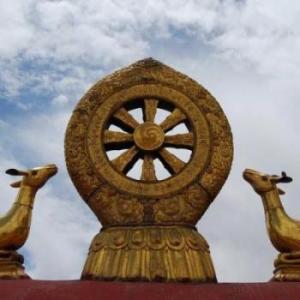
Fig. 1.7--Two samargh (a kind of divine Persian bird similar to a phoenix) around the central "man-in-the-sun" disc seen in mosaic form atop the entrance to the Nadir Divan-Beghi Madrassah, Lyab-i-Hauz
Fig. 1.8--The Ark of the Covenant. Two kneeling winged seraphs facing each other atop the ark like the two birds in the Circle of Peace symbol (albeit with wings oriented forward instead of backwards). Little gold wavelets atop the ark, like the waves of an ocean; and scales of gold below, like scales of fish in the same ocean; remind us of the Pacific Ocean between Japan and California
Fig. 1.14--The Japanese "hi-no-maru" (Circle of the Sun) flag, showing the plain red disc of the sun against a field of pure white. This archetypal symbol will be explored much further in Chapter 2.
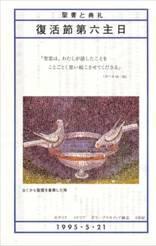
Fig. 1.4--The two doves seen on either side of the bowl in the mosaic from the 5th century Galla Placidium in Ravenna (as seen on Japanese Catholic Sunday missalettes on May 21, 1995).
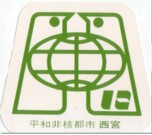
,_daughter_of_the_Roman_Emperor_Theodosius_I,_Ravenna,_Italy_(19521759022)_5312.jpg)
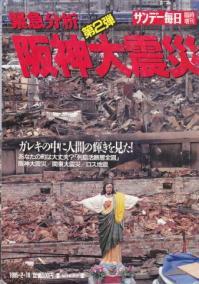
Fig. 1.3--The Takatori statue standing as if resurrected above the rubble of the Kobe Quake, as it appeared on the cover of the Sunday Mainichi roughly one month after the quake
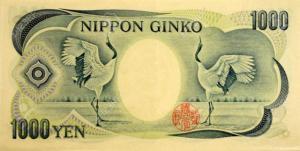
Fig. 1.10--The Japanese 1000 yen note with two cranes facing each other on either side of a central white disc, very reminiscent of the Galla Placidia doves of Fig. 1.1.
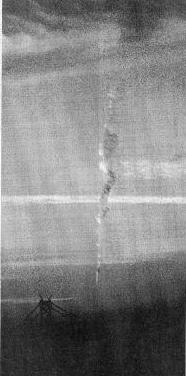
Fig. 1.1--A mysterious "earthquake cloud," as it was called by the Yomiuri Shinbun, (Yomiuri Daily) above the area of the epicenter of the Kobe quake (i.e., the tip of Awaji Island, which juts into the Akashi Straits) on January 9, 1995, nine days before the Kobe Quake.The top of the Akashi Straits Bridge--under construction at the time--can be seen at the bottom left.
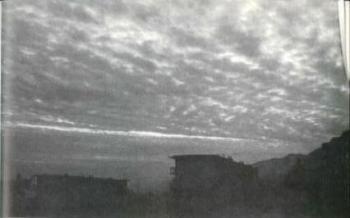
Fig. 1.2--From
the Japan Times Special Report on "The Great Hanshin Earthquake," a
caption reads, "The skies over
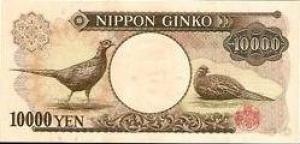
Fig. 1.11--The Japanese 10000 yen note with two birds oriented toward each other on ether side of a central white disc.
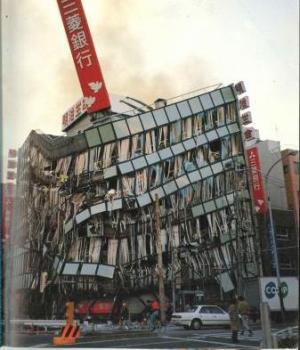
Fig. 1.12--The
devastated Sumitomo bank building in the aftermath of the Kobe Quake with two
doves in flight on the red sign above. Notice the truck to the right with the
"Co-op" department store logo and words, as if to tell us the two
doves of Sumitomo were a sign of the "cooperation" of the
Fig. 1.13--A large, pagan, Atlas-like figure at the hypocenter of the Nagasaki nuclear bomb dropped by American forces on August 9, 1945 during an annual memorial service. Notice the two doves flanking a central circle below the figure like the Circle of Peace symbol at the ends of the earth.
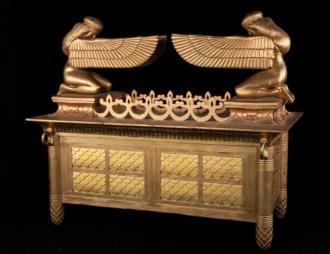
Iconography is forbidden in Judaism and Islam as a form of idolatry, so it is remarkable that the only rare exceptions we have noted in both religions so closely match the Circle of Peace symbol at the ends of the earth.
The symbol of a circle is so ubiquitous in Japan that we might properly call Japan "The Circle Civilization."
Japanese-owned 7-11 stores in the area of the Reseda Quake contain logos on signs that look as much like "117" as "711," pointing us to the day of the LA and Kobe quakes, with a motto that proclaims "Oh thank heaven for 711!"
Just as there are Seven Tables of the Grail in Space, so too are there Seven Tables of the Grail in Time--what we might respectively call the 7 Geographical Tables, and 7 Temporal Tables, of the Grail--meaning all time and space are contained in this idea.
After two heretical Temporal Tables of the Grail--the 5th and 6th, one led by Japan the other by Masonic America--the 7th Temporal Table of the Grail returned to Catholic hands once and for all with the Kobe Quake of January 17, 1995.
According to Gueranger, there are Seven Ages of the human race, and we are now in the Seventh and final Age.
The Seven Temporal Tables of the Grail have become manifest in this the Seventh Age of the Church.
Gueranger also writes that the symbol of these Seven Ages of the Church are in the six pots of water from the Wedding Feast at Cana, waiting for a seventh pot to be filled with Wine from the True Vine of Christ.
A seventh stone pot waiting to be filled with the Blood of Christ points to the Cup of the Last Supper, and then to the Grail of the Pacific Basin
A la Plato, The cathedrals of this earth are mere imperfect copies of this great Grail Cathedral of the Universe; and if this be true, all laws of the earth must conform to it and all must convert to the Catholic Faith.
The laws of the Catholic Church in the Middle Ages--when the great cathedrals of this earth were built--have never changed or been abrogated, and never will be, despite "progressive" men's attempt to do so or to ignore them altogether
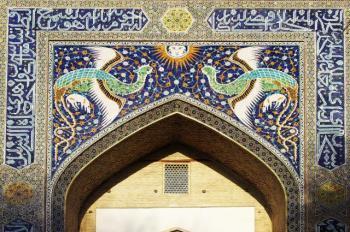
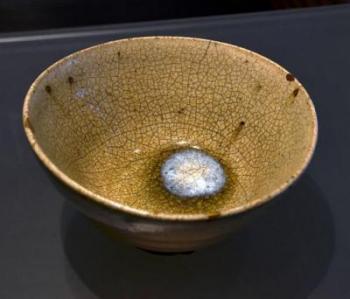
Just as the war-like aspects of sumo wrestling reflect the events of World War II, so too do the religious aspects of sumo symbolize the Pacific Basin in its pre- and post-war manifestation, indicating it as a "sacred place."

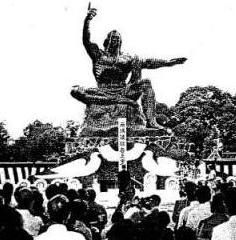
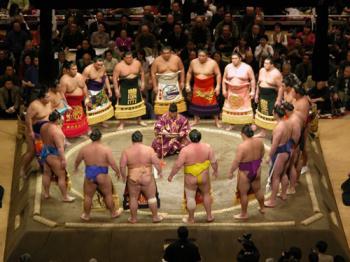
Fig. 1.15--The sumo wrestlers gather around the sumo ring in their doyho-iri (or "ring-entering ceremony") in unconcious demarkation of the Pacific Rim. They will then proceed to unconsciously ritualize the beginning, middle and end of World War II, and the two earthquakes of Los Angeles and Kobe on January 17, 1994, and January 17, 1995.
Fig. 2.1--This image from the Japan Times Special Report on the Kobe Earthquake shows the epicenter at the tip of the "finger" of Awaji Island crashing across the Akashi Strait into the Honshu mainland. Osaka Umeda Station can be seen to the right and the city of Akashi (text blurry) in a white coastal sliver to the left of the photo, which will both be of great significance as we continue through this treatise.
Fig. 2.2--A broader view of Awaji Island within the context of the main island of Honshu (containing "Osaka") and Shikoku (containing "Takamatsu"). Notice how Awaji looks like the profile of a large human hand reaching out to "touch" the Japanese mainland, much like God's hand in Michelangelo's Creation. The Kobe Quake emanated from the every tip of this seemingly outstretched index finger.
Fig. 2.3--The finger of God reaching out to the finger of Adam to infuse the latter with a soul, from the ceiling of the Sistine Chapel by Michelangelo. This section of the work is called "The Creation" and resembles the "Hand of God" of Awaji Island reaching out to "touch" the Kobe region and infuse it with a soul in the Kobe Quake.
Fig. 2.4--The cover of the book Sayonara, Michelangelo by Waldemar Januszak depicting the vital index finger of God reaching out to touch the lifeless index finger of Adam against a hi-no maru rising sun symbol on a white field, in reference to the Japanese flag.
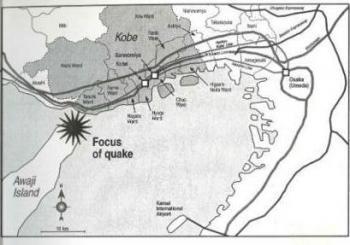
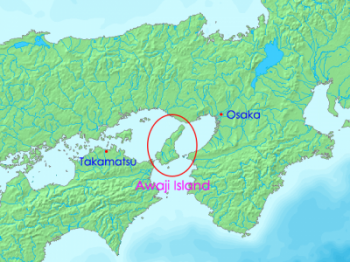
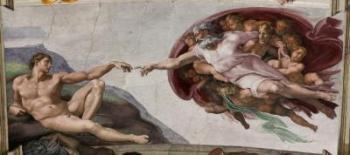

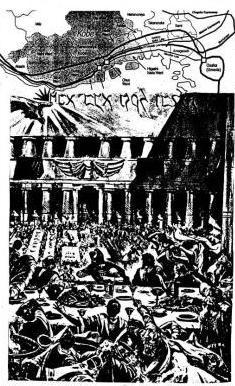
Fig. 2.5--The hand writing on the wall from the Book of Daniel, as seen in a graphic from the New American Bible, superimposed over Awaji Island in the Kobe Quake, as seen in Fig. 2.1 (from the Japan Time Special Report from the Kobe Quake). The chaotic panic of the Babylonians is similar to the panic of the Japanese in many office camera videos from the Kobe Quake.
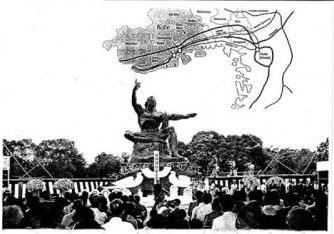
Fig. 2.6--The hand writing on the wall from the Book of Daniel, as seen in the large Atlas-like statue of Fig. 1.13 at the hypocenter of the Nagasaki nuclear bomb superimposed over Awaji Island in the Kobe Quake, as seen in Fig. 2.1 (from the Japan Time Special Report from the Kobe Quake), with the two doves below representing Japan and California in the Circle of Peace. The Kobe Quake came on the 50th anniversary of the Nagasaki (and Hiroshima) nuclear bomb and was the largest national disaster since that infamous event.
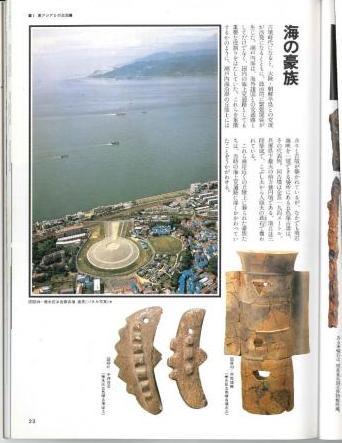
Fig. 2.8--Goshikizuka kofun as it appears again in the Kobe Museum Guide. The base of its keyhole (mystically?) points out toward the tip of Awaji Island--the epicenter of the Kobe Quake--far across the Akashi Straits, where so many mystical events occurred on the morning and in the week preceding January 17, 1995.
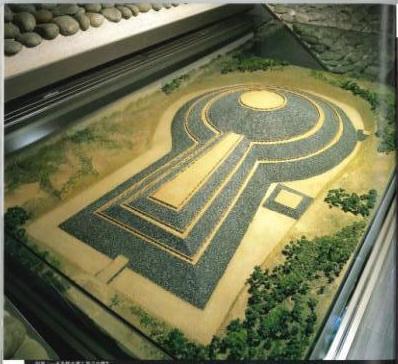
Fig. 2.7--The Goshikizuka kofun as it appears in a glass case at the Kobe Museum. (This image from the Kobe Museum Guide.) Notice it's perfect keyhole-shape, like Vatican Square. furthermore, little clay armored soldiers in helmet with sword would be lined up along its rim to protect the contents within, just like the many statues of saints standing along the roof of the Bernini columns in Vatican Square representing the "Church militant."
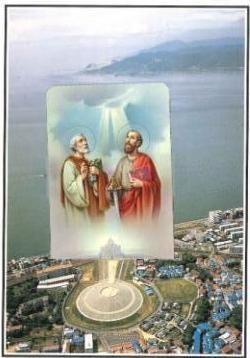
Fig. 2.9--If one inserts a Sts. Peter and Paul prayer card in a little slit at the base of the kofun (which we saw in the Kobe Museum Guide), we see that St. Peter's Basilica fronts a perfectly formed St. Peter's Square in the form of the Goshikizuka kofun. Meanwhile, from the top of the prayer card, a light seems to emanate from the tip of Awaji Island, just as it does in Fig. 2.1.
The epicenter of the Kobe Quake was from the tip of Awaji Island, looking much like God's finger in Michelangelo's Creation and transforming Kobe from the "Gate of the Gods" into "The Gate of the One True God"--the Japanese themselves restoring this image just prior to the Kobe Quake.
The epicenter of the Kobe Quake emanating from the tip of the finger of Awaji Island also reminds us of the "hand of a man"' from the Book of Daniel writing on the wall of Belshazzar's palace and striking terror into the hearts of his quests.
The words "mane, thecel, and pares" written by the had of a man on the wall of Belshazzar's palace (and on the Kobe coastline) remind us of the ruthless killing of Tecla Hashimoto among tens of thousands of martyrs and the fact Japan has been "weighted in the scales and found wanting."
"Babel" also means "The Gate of God" and therefore Kobe is another Babel, with another Tower of Babel attacked at its foundation in the Kobe Quake and at its head by the Maritime Museum, as in Genesis 3:15.
Babel lay in a Fertile Crexcent and the area of the Kobe Quake also comprises a Fertile Crescent, the only difference being that Babylon was handed over to the "Medes and Persians" while Japan has been handed over to that which is symboliaed by the "risen" Takatori Sacred Heart Statue of Christ.
The idea of a more powerful Christian God defeating the less powerful gods of Japan in connection with a series of earthquakes (like LA and Kobe) is an idea that was in the mind of Japanese Buddhist priests and the Japanese Emperor about 415 years ago.
The term "Babylon the Great" may refer to Rome at the end of time, and thus Kobe, whose name is synonymous with "Babylon (i.e. "The Gate of God") may also be another Rome.
The Rome-like and Petrine-like symbols of Kobe include the inverted cross of the earthquake cloud, the rooster weather vane of the ijinkan house, the St. Peter's Takatoris statue, and the Goshikizuka kofun.
The City of San Pedro directly across the Pacific Ocean is further confirmation of the Petrine nature of Kobe.
The keyhole-shaped goshikizuka kofun was built about the same time as the Vatican was founded and have similar statues of militant soldiers around its rim called "haniwa."
The goshikizuka kofun was the tomb of kings, like the Vatican, and also had tresures within them, like the Vatican Museum, and the finger of Awaji across the straits resembles God's Finger opening the Door of God in the Kobe Quake.
The photo of the Takatori Statue of Christ resembles the photo of Tecla on the Cross and in flames during her martyrdom.
The Takatori Statue appears to touch the veil of an icon of the Virgin with Child behind it just as the Cross of Johann Hashimoto appears to touch the veil of Tecla behind him.
There are many parallels between the mother, Tecla, with her children; and the Mother, Mary, with her child; as they both perish in the blaze.
The church behind the Takatori statue was burned down so that no stone stood upon another, just as Christ prophesied about the Jewish temple--and for the same symbolic meaning that this false worship has been destroyed.
The physical destruction of St. Peter's Takatori church is symbolic of the spritual destruction of St. Peter's Basilica by the Masonic Order.
Jesus said the stone that has been rejected has become the cornerstone, and Tecla, who has been rejected in one form or another by virtually everyone who calls themself "Catholic" (not to mention by the rest of humanity) has a memorial stone on the corner of Kawabata and Shomen streets.
Now that the "rock" of St. Peter has been destroyed in Rome, the rock of the Catholic Faith has been transferred to the rock of Tecla Hashimoto's martyrdom.
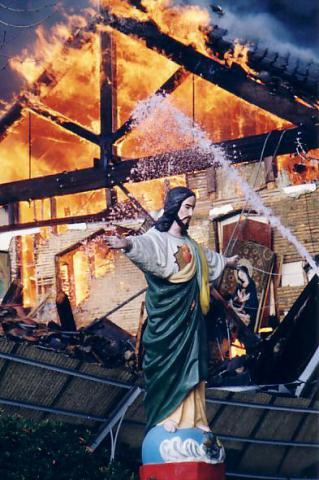
Fig. 2.10--The Takatori Sacred Heart Staute of Christ which we saw in Fig. 1.3 here seen in an "action shot" taken by a priest at the church named "Fr. Paul." Notice the icon of the Blessed Mother in the background with the Christ Child in her lap and the blaze from the quake rising up at her feet. It is very reminiscent of the Tecla Hashimoto postcard found nearby at the Franciscan House of Kyoto.

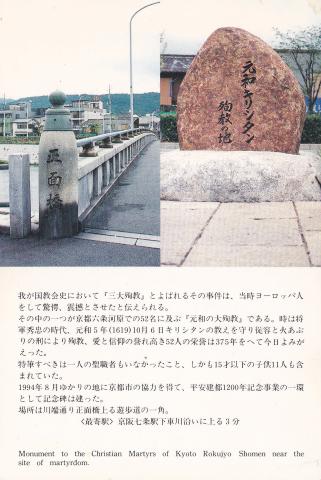
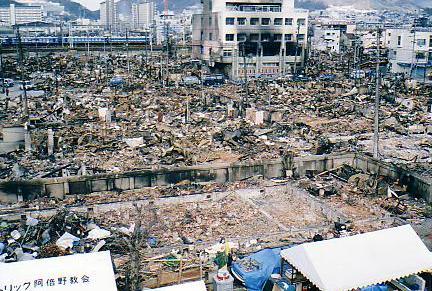
Fig. 2.11--The Takatori Sacred Heart Statue of Christ in another photo taken by Father Paul from atop his neighboring sacristy. Word on the street was that 1,000 had died in the area as far as the train seen in the distance The rectangular foundation directly behind the statue is the burnt-down Novus Ordo church building, with not a stone upon a stone, just as Jesus had prophesied of the Jewish temple in 33 A.D..

Fig. 2.12--The stone marking the site of Tecla Hashimoto's martyrdom at the corner of Kawabata and Shomen streets in the central part of Kyoto, Japan--a site which felt much heavy shaking in the Kobe Quake. The stone is pictured with a split image of the Shomen Bridge which traverses the Kamaogawa River, providing access to said stone. This is the stone on which the Catholic Church is now being rebuilt.